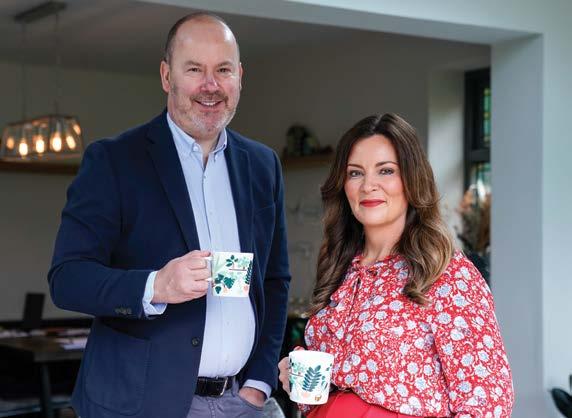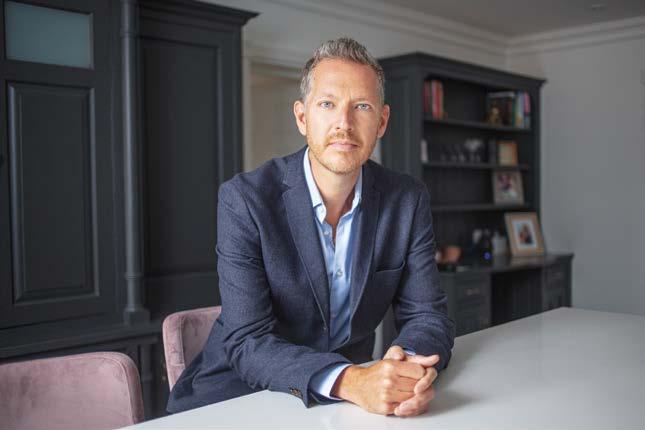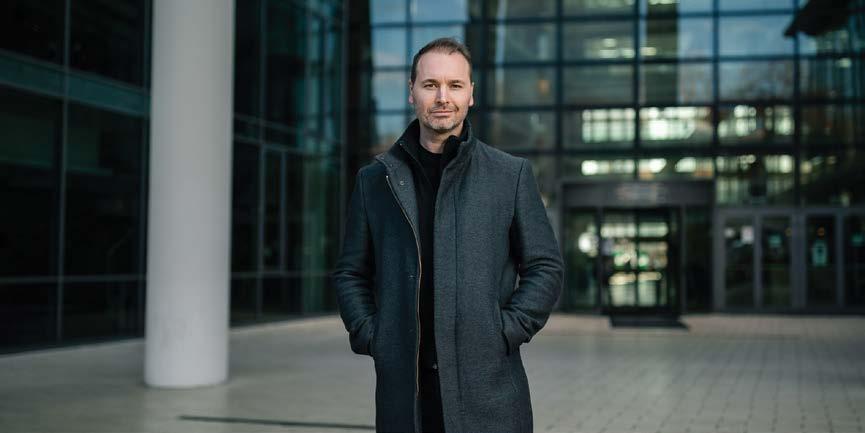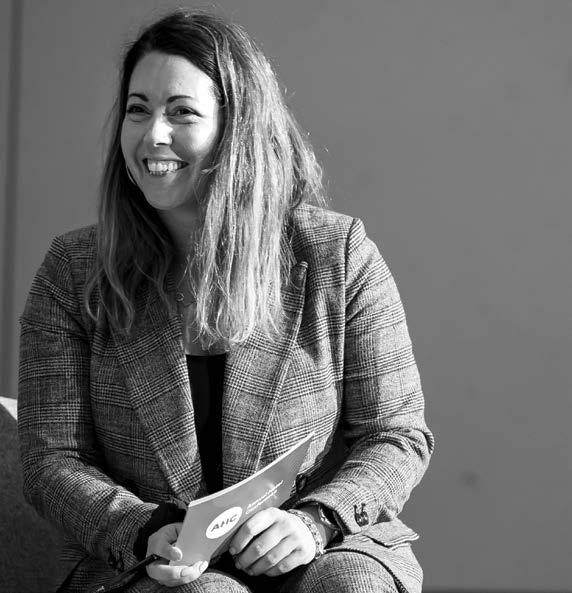








FEATURES EDITOR Patricia Cullen patricia.cullen@bncb2b.com
CEO Wissam Younane wissam@bncpublishing.net
MANAGING DIRECTOR Rabih Najm rabih@bncpublishing.net
ART DIRECTOR Simona El Khoury
EDITORIAL TEAM Tamara Pupic, Aalia Mehreen Ahmed
MEDIA SALES MANAGER Olha Kovalova olha.kovalova@bncb2b.com
REGIONAL DIRECTOR Andy B. andy@bncb2b.com
CONTRIBUTING WRITERS Joshua Fields, Lee Chambers, Adam French, Euan Cameron, Xiao Ma, Samantha-Jane Agbontaen, Claudine Reid
SUBSCRIBE Contact subscriptions@bncb2b.com to receive Entrepreneur United Kingdom every issue.
COMMERCIAL ENQUIRIES sales@bncb2b.com
Access fresh content daily on our website

As February rolls in, love is in the air-and in our pages. This month, we explore love in its many forms: passion for your work, partnerships that flourish (or flounder), and the tough but necessary art of letting go. Business, much like love, is about connection, growth, and sometimes, painful separation. Our February issue delves into these dynamics with stories that inspire, challenge, and provoke.
The feature“Better Together?” raises a question every entrepreneur must face: Is it better to have a co-founder or go it alone? The answer is as nuanced as any relationship. A co-founder can be a trusted ally, someone to share both triumphs and tribulations. But going solo offers autonomy and singular vision. We speak to founders who’ve experienced both paths, and their insights may help you decide which is right for your entrepreneurial journey. While we celebrate connection, we also explore separation. Our cover story “Time to break up with your business - let’s talk exits!” couldn’t be more fitting for the month of love, where breakups can lead to breakthroughs. Entrepreneur UK sits down with business partners who’ve not only
navigated personal divorces but also managed to sustain— and even grow—their ventures. Their story of separation shows that respect and focus can turn a split into strength.
This issue takes us on a trip outside the capital city of London. As the startup ecosystem expands, many founders are choosing to build their businesses outside London. In “Why Tech Startups Are Ditching London: The Rise of Regional Hubs,” we examine how these entrepreneurs are leveraging local resources, finding talent, and creating thriving communities away from the usual hotspots. Could your next big move be outside of the capital?
No love-themed edition would be complete without a nod to relationships in the workplace. In the “Love Language of Leadership” piece,we unpack how emotionally intelligent leaders who understand and apply love languages can build stronger, more engaged teams. From words of affirmation to acts of service, this feature reveals how a little more understanding and connection can transform your team’s culture.
Of course, love isn’t always rosy. Sometimes, the greatest act of love—whether for yourself, your team, or your business—is letting go. In Breakup Season: It’s Time to Let Go of What’s Not Working in Your Business, we confront the emotional hurdles that keep entrepreneurs tied to outdated strategies, partnerships, or goals. Moving on is never easy, but it’s often the catalyst for true growth.
Finally, we tackle an issue close to our hearts - and vital to the entrepreneurial ecosystem. In Why Access to Capital in the UK Needs to Change, we explore the structural barriers preventing diverse founders from realising their full potential. The current system isn’t just inequitable; it’s a missed opportunity for innovation and growth. Change is overdue, and we outline what needs to happen next.
This February, as you reflect on love in all its forms -whether for your co-founder, your team, your business, or yourself - we hope these stories inspire you to nurture the connections that matter and make bold decisions for the future. Love is about more than romance; it’s about growth, courage, and, sometimes, knowing when to let go.
Happy reading,
Patricia Cullen Features Editor, Entrepreneur United Kingdom


→ Childhood friends Tiger-Lily Beck and Demi Smith, co-founders of Flex in the City
For many, the idea of running a business with your best friend sounds like the ultimate dream. Who wouldn’t want to swap office politics for brainstorming sessions over coffee, or the dreaded 9-5 grind for the flexibility to work on your own terms? by
PATRICIA CULLEN
For Demi Smith and Tiger-Lily Beck, co-founders of Flex in the City, a London based recruitment agency the reality of entrepreneurship is far more complex - and infinitely more rewarding - than the glossy social media highlight reels suggest.
“You have the ability to work anywhere, which gives you a lot of freedom,” says Beck, reflecting on one of the unexpected perks of starting Flex in the City, a company that champions remote and flexible work opportunities.
“In the sector we’re in and with the people we work with, that gives us the ability to work all over the country.”
But freedom comes with sacrifice. Smith, who left a stable job to launch the business, admits that the entrepreneurial journey is not without its challenges. “You have to sacrifice a lot of time. There’s a lot of hard work, and that means you may miss out on some things in your personal life,” she says. “You also have to make a financial sacrifice as well. We left jobs that paid us regularly every month, and losing that regular income is a step into the unknown when you start a business.”
The pair’s candid reflections reveal that while entrepreneurship offers freedom, it demands resilience and a willingness to embrace uncertainty.
For those considering the leap into business ownership, Beck believes patience is a crucial trait.
“You have to be patient. Not everything happens when you want it to, or things get delayed, so being patient is key,” she explains.
Smith agrees but adds that patience alone isn’t enough. “You also need to be dedicated. There’s no point working hard towards something if you lose interest when it doesn’t go exactly as planned. You also need to be resilient when things get tough,” she says.
Passion also plays a vital role in
their success. “Being passionate about your subject area is really important,” Beck adds. “That can help when things get challenging.”
Beyond personal traits, the ability to build meaningful relationships has been a game-changer for Flex in the City. “Relationships can be the difference between your business succeeding and not,” Smith says. “Learning how to do that effectively has been a huge help for us.”
Starting a business means stepping into a world of uncertainty — something that Smith and Beck have experienced firsthand.
“Sometimes with tears!” Smith admits with a laugh when asked how they cope with the risks involved. But she quickly shifts to a more serious note. “Having a longterm goal is so important. It helps keep you focused on the end game and can be the drive you need to keep going.”
The duo also credits their partnership for helping them navigate the rough patches. “It’s really great that we have each other as co-founders,” Beck says. “We’re not alone, and having each other during those difficult periods is so helpful.”
One of the biggest misconceptions about entrepreneurship, the pair explains, is the idea that business owners have unlimited flexibility. Beck notes that while there’s a lot of freedom, “you do lose a lot of the work-life balance a 9-5 job gives you. You always have to be available at a moment’s notice as your business is your baby.”
Smith adds, “Everything feels personal. Any rejection or something not going exactly to plan can feel like a personal slight, but you have to try and look beyond that.”
For many, financial insecurity is another overlooked challenge. “I don’t think people really understand the risks to financial security running a business can have,” Beck says. “Losing that monthly

paycheck is a huge risk that can be daunting, especially when you are starting out.”
Social media often paints a glamorous picture of entrepreneurship, but both co-founders are quick to dispel that myth. “People think entrepreneurs have everything planned in advance, but you have to be flexible and constantly adapting to change,” Smith says. “You don’t need to have everything planned.”
Beck chimes in, “You also need to be prepared that you’re going to have to wear 10 different hats. You need to be an accountant one moment, copywriter the next, COO the next, and that can be tough when you’re starting. It can also mean you’re working long hours — it’s not all glamorous!”
THE STRENGTH OF A STRONG PARTNERSHIP
Running a business with a best friend can be tricky, but for Smith and Beck, it’s been their greatest strength. “People say either it must be so easy or it must be really hard starting a business with your best friend, and in all honesty, I wouldn’t go into business with any friend,” Smith says. “But we have a sisterly bond. We lean on each other for different things and play to each other’s strengths.”
Their complementary personalities
YOU ALSO NEED TO BE DEDICATED. THERE’S NO POINT WORKING HARD TOWARDS SOMETHING IF YOU LOSE INTEREST WHEN IT DOESN’T GO EXACTLY AS PLANNED. YOU ALSO NEED TO BE RESILIENT WHEN THINGS GET TOUGH.” “ }}

→ Friends in business: balancing trust, dreams, and challenges.
“
WE ARE GOOD AT LEANING ON EACH OTHER’S DIFFERENT STRENGTHS, AND I THINK THAT’S WHY WE WORK SO WELL TOGETHER, BUT IT’S NOT SOMETHING YOU CAN DO WITH EVERY FRIEND.”
have proven essential. “What works for us is having the balance between us,” Beck explains. “If one of us is less patient or less confident, the other will be able to step in and bridge that gap. Having someone the opposite of you helps.”
Smith adds, “We also know each other so well we can leave some bits unspoken, but we’re not scared to call each other out if needed. We are good at leaning on each other’s different strengths, and I think that’s why we work so well together, but it’s not something you can do with every friend.”
When asked what advice they would give to aspiring entrepreneurs, both Smith and
Beck agree on one thing: be prepared for the unexpected.
“Don’t be afraid to take risks,” says Smith. “But also be prepared for the emotional journey it takes you on. It’s not just about the business side of things — it’s about personal growth too.”
Beck offers a final piece of advice: “Find someone who complements you and can support you through the highs and lows. Having that support system has been crucial for us.”
Their journey with Flex in the City highlights that entrepreneurship is far from a straight path, but with resilience, passion, and the right partner, it can be an incredibly fulfilling one. It is a powerful reminder that building a business, especially with a best friend, is both an exhilarating and challenging journey. The flexibility and freedom that entrepreneurship offers are tempered by the sacrifices, long hours, and constant need for adaptation. Smith and Beck’s willingness to embrace these challenges, however, has led them to growth, both professionally and personally.
For aspiring entrepreneurs, the key takeaway from their experience is the importance of patience, resilience, and strong relationships. As they navigate the ups and downs of business ownership, their partnership remains their greatest asset. Their complementary strengths and shared commitment to the mission of Flex in the City have helped them not only survive but thrive in a competitive industry. Ultimately, their story illustrates that entrepreneurship is not a glamorous pursuit but a deeply rewarding one when approached with authenticity, dedication, and a sense of purpose. As they continue to grow their business, Smith and Beck underscore the advantages of building a company alongside a friend.
Navigating a business breakup can be as complex as a personal one. Here’s how to keep your venture thriving after separating from a business partner or co-founder. by
PATRICIA CULLEN

When entrepreneurs James and Eimear Maguire, co-founders of Maguire Law, a Manchester based law firm, separated as a couple, they faced a challenge few business owners are prepared for: how to navigate a personal breakup while keeping their business partnership intact. Their journey offers valuable lessons for entrepreneurs on how to maintain professionalism, protect their business, and ultimately build a strong working relationship post-breakup.
The breakdown of a personal relationship can send shockwaves through a business, especially when both parties are deeply involved in its day-to-day operations. For James and Eimear, the separation was a significant emotional and professional hurdle.
“Behind closed doors it was very challenging as you are dealing with your personal feelings but ever conscious of the outward impact on colleagues and business contacts,” James recalls. “At the time we were a fledgling business and we were very conscious that it was do or die.”
The couple knew that their business, Maguire Law, was at a pivotal stage, and any instability could jeopardise everything they had built. “The relationship breakdown raised big questions about whether I could remain in the business (given I am nonlegal), which would have meant even further sacrifice both on career and financial fronts,”

Eimear shares. Despite the personal upheaval, both James and Eimear remained committed to their shared vision for the business, knowing that the stakes were high.
Key adjustments to keep the business afloat
Maintaining a professional front while managing personal turmoil is no easy feat, but James and Eimear made crucial adjustments to ensure their business continued to thrive.
“We tried to keep the personal stuff private,” Eimear explains. “We also acknowledged the importance of communication. We know that people are not naive and detect huge changes of energy, so we told the team what was happening and reassured them of our commitment to the business.”
Transparency with their team proved to be a double-edged sword. While most employees appreciated their honesty and supported them through the transition, not everyone was comfortable with the news.
“It worked for some who were very supportive and understanding and scared one person off who told us that she thought the marriage ending would end the business,” Eimear admits. “We
worked with a team of people in which nobody had ever experienced divorce!”
The couple’s focus on open communication and professionalism helped steer the business through this uncertain period. By addressing the situation head-on, they avoided the potential pitfalls of gossip and speculation.
One of the most surprising outcomes of their experience was how the business itself became a foundation for their post-relationship bond.
“The business created the treasured, respectful relationship we have now,” Eimear reflects. “Had we not had to put our personal differences aside and be professional, the relationship, like so many, could have descended into acrimony.”
Their shared commitment to the business gave them a common goal to work toward, even during difficult times.
“We both had a strong desire to drive the business and succeed. No fall-back plan! We kept showing up for the business and the team and were ultimately rewarded with a very happy and beneficial working relationship.”
“WHEN IT SEEMS HARD AND INSURMOUNTABLE – DIG DEEP – FIGHT FOR THE ULTIMATE GOAL OF ACHIEVING THE BUSINESS DREAM YOU ALWAYS WANTED. GET UP, GET READY, AND PUT YOUR SMILE ON.”
This determination to keep showing up, despite personal challenges, was key to their success. For entrepreneurs facing similar situations, James and Eimear’s story highlights the importance of focusing on the bigger picture and the shared goals that brought the partners together in the first place.
For entrepreneurs who find themselves in a similar situation, James and Eimear offer practical advice to help maintain a healthy business relationship post-breakup.
“When it seems hard and insurmountable – dig deep – fight for the ultimate goal of achieving the business dream you always wanted,” she advises. “Get up, get ready, and put your smile on.”
The co-founders emphasise the importance of remembering why you went into business with your partner in the first place. “Remember you once had a lot of faith in that person. And whilst, on a personal/marriage level, that didn’t
work out, they still possess the qualities and the reasons you went into business together in the first place.”
James and Eimear also stress the importance of professional boundaries. Keeping personal issues separate from business operations is crucial to maintaining stability and trust within the company. By focusing on shared goals and remaining professional, they were able to navigate their personal challenges without Jeopardising their business.
The power of resilience and respect
The Maguires’ experience demonstrates that while personal breakups can be incredibly challenging, they don’t have to spell the end of a business partnership. With resilience, respect, and a shared commitment to success, it’s possible to maintain a healthy working relationship.
“The business forced us to
challenges, the Maguires’ journey offers hope and a blueprint for success.
Final thoughts: Turning personal challenges into professional growth
Breaking up with a romantic partner is never easy, but for entrepreneurial couples, it presents unique challenges that require careful navigation. James and Eimear Maguire’s story shows that it is possible to separate personally while continuing to thrive professionally. Their key takeaways? Communicate openly, remain professional, and remember the qualities that made your business partner the right fit from the start. “Keep showing up for the business. You’ll be rewarded with a working relationship that can withstand even the toughest personal challenges.”
For entrepreneurial couples facing a personal breakup, James and
complex intersection of personal and professional life. Their journey underscores the importance of remaining focused on long-term goals, even when faced with emotional and personal turmoil. By putting their business first, they not only preserved their company but also grew as individuals and as partners. Their ability to compartmentalize their personal struggles and separate them from their professional responsibilities proved vital in safeguarding the integrity of Maguire Law.
In addition to communication and professionalism, their journey illustrates the power of perseverance. While many couples in similar situations might have faltered, James and Eimear found strength in their shared vision. Their focus on showing up every day - no matter the personal hurdles- was a critical factor in ensuring the
THE BUSINESS FORCED US TO MAINTAIN A LEVEL OF PROFESSIONALISM AND RESPECT THAT MIGHT NOT HAVE BEEN POSSIBLE OTHERWISE. WE’VE EMERGED STRONGER FOR IT, BOTH AS BUSINESS PARTNERS AND AS CO-PARENTS.”
maintain a level of professionalism and respect that might not have been possible otherwise,” says Eimear. “We’ve emerged stronger for it, both as business partners and as co-parents.”
Their story really illustrates how personal challenges can unexpectedly drive success. For entrepreneurs navigating similar
Eimear’s experience offers a powerful reminder: breaking up doesn’t have to mean breaking down. With the right mindset and approach, it can even lead to a stronger, more resilient business partnership. James and Eimear’s story is not only an inspiring testament to their tenacity but also a valuable guide for entrepreneurs navigating the
business thrived. It is a reminder that hard work and determination can often transcend even the most difficult personal challenges. Their experience also highlights the importance of empathy and support in the workplace. By being transparent with their team, they allowed room for understanding and flexibility. The fact that
not all employees responded positively to the news is a reality for many business owners, but it also served as an opportunity for James and Eimear to reinforce the culture of respect and diligence that underpinned their company. Maintaining this culture helped shield the business from the destabilizing effects of gossip and negativity. For other entrepreneurs facing similar situations, the Maguires offer one crucial piece of advice: never lose sight of the bigger picture. In times of personal difficulty, it can be easy to become consumed by emotion, but focusing on the shared goals and the purpose that led to the partnership in the first place helps to foster growth and stability. And while it may seem impossible at times, the ability to remain resilient and continue to work together with respect can lead to stronger partnerships, both personally and professionally. Ultimately, the Maguires’ journey demonstrates that challenges can be transformative. Their ability to navigate the breakup while strengthening their business and their relationship as co-founders proves that adversity, when met with resolve and mutual respect, can be a powerful catalyst for personal and professional growth. Their story is a reminder that even the most difficult personal challenges don’t have to derail a business; they can, in fact, drive it forward in unexpected and meaningful ways.
→ Jim and Dannii Mee, the husbandand-wife duo behind Rat Race Adventure Sports.

ARE TWO HEADS BETTER THAN ONE IN BUSINESS? EXPLORING THE HIGHS AND LOWS OF CO-FOUNDING WITH YOUR SPOUSE, FRIEND, OR BUSINESS PARTNER, AND WHETHER GOING IT ALONE MIGHT BE THE SMARTER MOVE.
by PATRICIA CULLEN
Entrepreneurship often starts with a spark — an idea that demands nurturing, grit, and relentless passion. But the question every aspiring founder faces is: should you go it alone or find someone to share the load? The age-old debate between solo founders and co-founders takes on a romantic hue this February, especially when considering cofounders who double as life partners or long-time friends.
The Passion And The Peril Of Partnering Up
So, how do you make it work when you’re closely linked to your business partner? We spoke to four entrepreneurial duos who shared candid advice about navigating the complexities of both business and personal relationships. Their experiences shed light on the advantages and potential pitfalls of co-founding a business with someone close to you.
Jim and Dannii Mee, the husband-and-wife duo behind Rat Race Adventure Sports, know firsthand that mixing business and personal relationships can be both rewarding and challenging. Their advice? Be prepared for disagreements.
“Know that you will disagree, and arguments will occur—probably more heated than ‘regular’ colleagues would have, as the passion and emotional investment in the business is total,” says Jim Mee. “When this occurs, take time to reflect and take stock before
“
It is vital to lay out the rules of fromengagement the outset. Discuss what you both want now, in the next year, and in the next five years. Create a contract as if preparing for the worst-case scenario, like a divorce, while still on good terms.”

taking entrenched positions. Compromise is key, and a united front to the rest of the business is essential.”
Compromise isn’t just crucial in romantic relationships— it’s a fundamental part of any successful co-founding partnership. Boundaries are equally important. Without clear separation between personal and business lives, tensions can escalate.
Michelle Laithwaite, CEO of FuelHub, a meal delivery service she co-founded with her husband James, stresses the importance of setting boundaries.
“Make sure to set clear boundaries between your business and personal lives,” she advises. “Clearly define each partner’s role and responsibilities within the business, and approach work matters professionally. This helps prevent misunderstandings and ensures you’re not stepping on each other’s toes.”
The Laithwaites’ golden rule? No business talk on date nights. “Separate personal and business time,” says Michelle. “Set firm boundaries, like avoiding business discussions during personal moments. Prioritising quality time together outside of work is crucial for nurturing your relationship.”
The emotional toll of running a business is immense, and when your co-founder is also your life partner, the stakes are even higher. It’s not just about profit and loss - it’s about preserving your relationship through the inevitable ups and downs of entrepreneurship.
Jim and Dannii Mee emphasise the importance of stepping away from work regularly.
“Enjoying some regular downtime from the business on non-work-related trips is essential,” says Dannii. “We work in travel and adventure, so it’s hard to uncouple that for holidays sometimes! But weekends away with friends or family holidays that are totally unrelated to what we do day-to-day really help.”
For the Laithwaites, maintaining balance means respecting each other’s strengths and weaknesses.
“Respect each other’s strengths,” says Michelle. “Acknowledge and appreciate the unique skills each partner brings to the table. Focus on collaboration rather than micromanaging or letting work frustrations spill over into your personal life.”
Not all co-founding duos are romantic partners. Long-time friends can make great business partners - provided they lay the groundwork for a professional relationship. Despite sharing the same surname, Russell Ward and Byron Ward, co-founders of Meta Team, met on the golf course over two decades ago. Their friendship evolved into a thriving business partnership, but not without some important lessons along the way.
“Define roles early on and establish clear expectations,” advises Russell. “It is vital to lay out the rules of engagement from the outset. Discuss what you both want now, in the next year, and in the next five years. Create a contract as if preparing for the worst-case scenario, like a divorce, while still on good terms.”
While friendship provides a strong foundation of trust, it can also complicate decision-making if expectations aren’t
clear from the start. Russell believes that open communication and mutual respect are essential.
“We make it a point to talk things through, both professionally and personally,” says Russell. “Having different, complementary roles, we respect each other’s domains of responsibility. I focus on sales, contracts, and finances, while Byron oversees product design, delivery, and marketing. Neither of us tries to take on the other’s role, thus avoiding unnecessary friction.”
The Golden Rules of Co-founding
So, what’s the secret to a thriving co-founder relationship? Across the board, our interviewees agreed on a few golden rules:
1/ Set Boundaries – Whether it’s no work talk in bed or keeping business discussions out of date nights, boundaries are essential to preserving your relationship.
2/ Define Roles Clearly – Avoid power struggles by clarifying each person’s responsibilities from the outset.
3/ Communicate Honestly – Open and honest communication is the glue that holds any relationship together, especially in business.
4/ Respect Each Other’s Strengths – Acknowledge what your partner brings to

the table, and avoid micromanaging.
5/Dream Big Together
– Ultimately, shared goals and a united vision are what keep co-founders aligned through challenges.
Russell Ward sums it up: “Be honest at all times. Admit mistakes and seek advice from your partner when needed. Make all major decisions together rather than assuming what the other would prefer. Dream big, but do so as a team.”
The Case for Flying Solo
While co-founding offers clear advantages in terms of shared workload, emotional support, and diverse skill sets, there’s another side to the story. Flying solo offers greater autonomy, faster decision-making, and the potential for complete control over your vision.
→ Ross Geddes, the solopreneur behind Finnieston Clothing, founded the brand himself, managing its growth and direction.
with my principles,” he adds.
The solo founder model is often associated with iconic entrepreneurs like Jeff Bezos and Oprah Winfrey, who built their empires largely without co-founders. But going it alone comes with its own challenges: decision fatigue, isolation, and bearing the full weight of success or failure.
The key question for any aspiring entrepreneur is this: do you thrive on collaboration, or do you prefer autonomy? There’s no one-size-fits-all answer.
Ross Geddes, founder of Finnieston Clothing says being a solopreneur has given him the freedom to make bold decisions without compromise.
“There’s no need to debate or dilute the vision – I can act on my values and instincts, which has been crucial in transforming Finnieston Clothing into a purpose-driven business. I’ve been able to steer the brand toward sustainability and social impact, despite criticism from the industry.”
This autonomy has allowed Geddes to focus on what truly matters: creating high-quality, ethical products and supporting causes I believe in, without being held back by differing opinions or clashing priorities.
“The journey has been challenging, but it’s also deeply rewarding to build a business that aligns entirely
In the spirit of Valentine’s Day, it’s worth noting that business partnerships—like romantic relationships—require nurturing, compromise, and a willingness to weather the storms together.
Jim and Dannii Mee offer a fitting piece of advice: “Don’t talk about work in bed!” It’s a reminder that even the most passionate entrepreneurs need to take a step back sometimes to preserve what matters most: their relationship.
For Antony and Richard Joseph, co-founders of the globally renowned design brand Joseph Joseph, their secret to working together as twin brothers is simple: define roles early on.
“With any business partnership, but especially when starting a company with a family member, you should define roles and responsibilities from day one. Working with family that you naturally trust can
be a definite advantage, but it can also blur professional boundaries,” says Antony Joseph, Creative Director “so it’s important to delineate roles based on each other’s strengths, and allow veto power within each area of expertise, creating a framework for mutual respect and accountability.” Defining responsibilities according to each person’s strengths and to grant decision-making authority in their respective areas, fosters a system of shared respect and responsibility.
Richard Joseph, the company’s CEO, adds, “Establishing this framework ensures you both feel empowered in your position within the business and are aligned with your broader vision. It also provides a clear decisionmaking process and ensures there are less
disagreements, and more time put towards thinking about the company’s future.
Importantly, it also helps build confidence in shared decisions, allowing you to stand united behind them, without feeling you’ve compromised on vision.”
Their advice for entrepreneurial duos? It’s all about leveraging complementary skill sets.
“Ensure your partnership is built on complementary skill sets and a shared commitment to equal contribution,” says Richard. “The magic of any successful partnership lies in leveraging strengths. Utilising complementary skill sets means you can divide your responsibilities effectively and establish a dynamic duo. So, if one partner excels in strategy and business development while the other shines at creative execution, you’ll
naturally cover more ground and avoid stepping on each other’s toes.”
As Antony Joseph emphasises, a partnership thrives when both individuals share the same work ethic and commitment.
“Ultimately, a partnership only thrives when both partners bring the same level of dedication and effort.,” he says. “ The key is to recognise that your differences are your biggest strengths, and your shared work ethic is the glue that binds you together.”
Balancing personal relationships and business can be challenging, especially when working closely together. Antony and Richard recommend consulting with a mentor to help maintain clarity and ensure decisions stay focused on business goals. They also agree that setting egos aside and prioritising a

Be honest at all times. Admit mistakes and seek advice from your partner when needed. Make all major decisions together rather than assuming what the other would prefer.
Dream big, but do so as a team.” “
shared vision fosters collaboration and strengthens both the company and the personal relationship. This approach builds mutual respect and trust, creating a solid foundation for both personal and professional growth.
Whether you choose to go solo or team up with a co-founder, the key to long-term success is striking a balance between ambition and connection.
In business, it’s often the strength of collaboration that makes the difference.
This February, experts weigh in on the art of business breakups and how founders can exit on their own terms.
by PATRICIA CULLEN
As February begins, entrepreneurs find themselves at a pivotal moment - just as Valentine’s Day sparks reflection in personal relationships, this month calls for business owners to evaluate their next steps. Whether it’s planning an exit, seeking a merger, or rethinking strategy, it’s a crucial time to assess where their business is headed.
Whether contemplating a sale, a merger, or a handover, the prospect of exiting a business requires careful deliberation and strategic planning. Just as Valentine’s Day encourages individuals to reconsider the paths of their personal connections, February serves as a moment for business founders to take stock and decide what comes next for the companies they’ve built.
→ Simon Daniels, Director at KBS Corporate, guides businesses through successful mergers and acquisitions.
} Plan your exit thoroughly: “Start by formulating a clear idea of your objectives—what are you looking to achieve?”
} Be flexible with timescales: “This increases your chances of achieving the highest possible value for your company, as well as the right deal for you.”
} Consider all types of deal structure: “Explore different options that may align with your long-term goals.”
} Be certain the new owner is the right fit for your company: “The emotional impact of the sale will be reduced if you know your staff will be in good hands going forward.”
} Maintain full focus on running your company: “By taking your eye off the ball, a downturn in performance could complicate any agreed terms or structures, putting the transaction at risk.

In this Entrepreneur UK feature, we dive into expert insights on how UK-based founders can navigate the emotional and practical aspects of business exits, ensuring a smooth transition into whatever comes next. For entrepreneurs in the UK, deciding when and how to exit their business is a critical decision, with far-reaching implications for both their professional and personal lives. While much of the focus tends to be on the financial aspects of exit strategies, one crucial component often goes unaddressed: the emotional impact on founders. Simon Daniels, Director at KBS Corporate, highlights that this emotional side is frequently overlooked but plays a key role in the exit process.
success means that cutting ties with it becomes one of the most important decisions a business owner will make during their working life. Coupled with the fact the founder will have emotional connections to some of their longerstanding employees.”
Daniels explains that the emotional impact of selling a business can be lessened if the exit is managed carefully, offering a smoother transition for the founder. “But we always advise a client that their exit doesn’t have to be as stark as simply handing over the keys and walking away. For example, the emotional impact can be lessened if the exit is phased – perhaps they would be suited by a private equity investment where the entrepreneur remains involved for the next few years under new ownership.”
Another important aspect of exits is recognizing that not all exits are the same.” }}
“Building a business from scratch and ultimately deciding to sell it is naturally a very emotive experience for any entrepreneur,” said Daniels. “The blood, sweat and tears, and, of course, money invested into making the company a
To ease this emotional transition, Daniels suggests that founders should negotiate deal structures that allow them to remain involved in a handover capacity, which ensures both the company and its employees are well

Build out clear roles and shine a light on your management team, step back from the day-to-day operations, and demonstrate to potential buyers that the business can thrive independently.”
→ Lewis Crompton, CEO and founder of STARTrading.
cared for during the transition. “Founders shouldn’t forget about negotiating deal structures which enable a business owner to remain in a handover capacity to ensure a smooth transition for the company and its staff, while allowing the existing shareholder to ease away gradually so that when they eventually part with the business they founded, it feels seamless and less emotional.”
Lewis Crompton, CEO and founder at STARTrading, who accepted a merger option last year instead of a full sale, sheds light on this key distinction. Though he has yet to sell his company outright, Crompton offers valuable insight on considering the level of exit that best suits your goals.
“Decide what level of exit you want. Not all exits are created equal,” Crompton advises. “What are you truly looking for and will a 100% exit give you that? What about a 50% or a 75% exit, which allows support to come in and the majority of the stress to be someone else’s? Do you want true partnership 50/50 or are you happy with less ownership, less responsibility but still having a hand and a say in how the company is run. Do you want to formally maintain control and decision making powers by keeping at least 51% of the company for yourself.”
For Crompton, a partial exit can provide a balance between gaining support and relinquishing full control while also reducing some of the pressures associated with running a business. In his case, the merger option allowed him to remain involved, but with a reduced role, thus relieving some of the burdens while still benefiting from the company’s ongoing success. Trying to be non-emotional about what you do with your business is key to finding the best outcome.
“Don’t let the stress and heartache lead to a rash decision but also don’t let the years of love and attention cause you to hold on to something that no longer serves you as it once did. After all, you have been serving the business to get it to this stage and you should be proud of that. Time to get excited about the next step!,” he advises.
A contrasting perspective is offered by Jessica DeLuca, founder and former CEO & Chairwoman of Cult Beauty, who successfully exited her business to THG.
DeLuca points out that a big part of a smooth exit is avoiding the need for an earn-out period, which can be done by having a solid plan for leadership transitions and keeping everything well-documented..
“I advise managing or eliminating the need for an earn-out period through robust succession planning and systematic documentation,” DeLuca suggests.
“Instead of finding yourself working as an employee in your own company post-sale, focus on creating a business that can thrive without you.”
DeLuca stresses that founders should work on creating a business that operates independently, which not only boosts its value but also provides the flexibility for a smoother and more advantageous exit.
“Start by developing comprehensive operations manuals and a crystal-clear company vision that empowers your team to make decisions aligned with the business’s goals.”
She also highlights the importance of cultivating a strong successor, someone who can take over leadership responsibilities before the transaction is finalised.
“Also, cultivate a strong successor—either by mentoring a deputy who can confidently run operations before the transaction or by stepping back into a chairperson or board role while allowing your successor to demonstrate their leadership.”
The ultimate goal, according to DeLuca, is to ensure the business is valuable because it operates independently of the founder, not because it relies on them. “The key is to create a business that’s valuable because it

operates independently of you, not because it relies on you. This approach can also increase the company’s value and provide greater flexibility in exit timing, enabling you to negotiate from a position of strength rather than necessity.”
Miles Kean, director of Private Banking at Arbuthnot Latham cites exiting a business is one of the most significant decisions an entrepreneur can make.
“The triggers for exit are varied - from personal motivations such as desiring a new challenge or feeling you’ve achieved your key goals, to external factors such as market dynamics or tax policies influencing this decision”, he says. Recognising these motivations early on can help an entrepreneur to shape a clear exit strategy that aligns with both their personal and professional aspirations.
“In our experience, business owners who start planning early

“FOUNDERS SHOULD ENSURE THEY VIEW THEIR BUSINESS WITH A COLD EYE, AND THROUGH THE LENS OF A POTENTIAL BUYER. IDENTIFY THE BUSINESSES DIFFERENTIATORS AND KEY SELLING POINTS.

loss of identity or purpose – can be significant.
“By focusing on both the financial and personal aspects of the exit, entrepreneurs can ensure that their post-exit life offers new opportunities to redefine success, whether through pursuing new ventures, spending more time with family, or taking on advisory roles. The key to a successful exit lies in clear and early planning and addressing the full spectrum of both practical and emotional considerations.”
Rowan Manning, CEO at ScarlettAbbott, also provides a compelling take on the importance of thorough preparation in any exit strategy. Manning notes that the motivation behind an exit is as unique as the founder, influenced by a mix of personal goals and the business’s market position. Regardless of the approach—be it through acquisition, IPO, or succession—great planning is essential to ensure a successful transition.
GET YOUR HOUSE IN ORDER.”
– and focus on aligning their goals with their exit plans – are better positioned to navigate both the emotional and logistical challenges that often arise. A well-thought-out plan can also ensure a smoother due diligence process, which can otherwise become an intense and taxing phase,” he warns. He advises to work closely with trusted wealth advisers and build a strong support team that can help manage this crucial stage. He warns that even with the right preparations, the emotional toll of letting go – such as the
“While the motivation behind a business exit is likely to be as unique as its founder – and depend on a combination of personal goals and the business’s structure, market position, and long-term vision – the main unifying element in all successful business exit strategy is great planning,” Manning explains. “Whether the best avenue is to be through acquisition, IPO, or succession, preparation is key. There are plenty of lessonrich examples out there, from Sergey Brin and Larry Page successfully transitioning Google into Alphabet, to WeWork’s infamous IPO collapse under Adam Neumann.”
Manning suggests that preparing for an exit should start 6-12 months in advance to ensure there’s enough time to fine-tune the strategy, consult with outside experts, and carry out thorough assessments.“An exit strategy should begin at least 6-12 months ahead of time. This allows founders to refine their approach,

engage with external advisors and complete all necessary due diligence. Any well-developed business exit strategy should deliver a compelling narrative outlining both the steps required to safeguard the owner’s smooth exit and ultimately a clear path to transition the business to an exciting new phase.”
Manning stresses the importance of seeing the business from a buyer’s perspective and preparing all aspects of the business for a potential transaction. “Founders should ensure they view their business with a cold eye, and through the lens of a potential buyer. Identify the businesses differentiators and key selling points. Invest in external support to get your house in order. Ensure financial reporting, legal compliance and operational systems are watertight,” she advises.
She also points out that one of the biggest obstacles in the exit process can be the owner themselves. “Ironically one of the most common stumbling blocks can be the owner themselves, often failing to adequately prepare for the transfer of leadership responsibilities,” Manning says. “Build out clear roles and shine a light on your manage-
→ Victoria Ansell, managing partner at Marktlink, highlights the value of holistic preparation in successful business exits.
ment team, step back from the day-to-day operations, and demonstrate to potential buyers that the business can thrive independently.”
Finally, Manning adds that a great exit is not simply about leaving; it’s about ensuring the business continues to thrive after the founder has stepped away. “A great exit isn’t just about leaving, it’s about leaving the business in a position to flourish without you.”
Victoria Ansell, managing partner at Marktlink, Europe’s largest independent M&A advisory firm, also brings a strong emphasis on a well-rounded strategy for business sales.
Ansell believes that successful exits are rooted in comprehensive preparation that goes beyond just financial documentation.
“In the complex world of business sales, preparation is everything. It’s not just about financial records, but a holistic approach encompassing organisational readiness, performance optimisation, and personal strategy,” says Ansell.
She also stresses that selling a business is not a one-time event, but a carefully orchestrated process.
“Successful business owners understand that selling isn’t a moment, but a carefully planned journey. This means ensuring every aspect of the business is polished and compelling—from operational systems to financial documentation. Performance matters—potential buyers aren’t just purchasing current revenue or profits, but future potential.”
Ansell adds that the human element, such as having a well-equipped leadership team and the equanimity to handle the transition, plays a crucial role in ensuring a successful sale. “The human element is equally crucial. A prepared management team, an emotionally intelligent approach, and family support can significantly influence transaction success. Entrepreneurs must consider not just the sale itself, but what comes after—personal financial planning, lifestyle transitions, and emotional readiness to move on.”
She concludes by pointing out the importance of professional advisers in navigating the complexities of an exit.
“Professional advisers become key navigators in this process, helping transform raw business potential into an attractive, strategic proposition. They guide owners through the intricate landscape of due diligence, financial implications, and strategic positioning.”
Ansell believes that a successful business sale is more than just a transaction—it’s a transition that honours the founder’s legacy while also opening up new opportunities. “Ultimately, a successful business sale is more than a transaction—it’s a meticulously choreographed transition that respects an entrepreneur’s legacy while creating opportunities for exciting new chapters.”
by LEE CHAMBERS

Inavigating the constantly shifting landscape of modern business, leaders are finding themselves having to be agile, present, and find time to pause amid the volatility. Amongst this, certain leaders have recognised just how valuable emotional intelligence is, and how it can be pivotal in cultivating the interpersonal connections that forge teams together. In this ever-evolving world we find
ourselves in, applying the concept of love languages into leadership may be the key to fostering cultures where teams are engaged, aligned and collaborative.
Emotional intelligence, sometimes referred to as EI, has been an increasing topic of discussion in the corporate world, especially over the decade. With an increasing focus on areas including
employee experience, talent acquisition and workplace wellbeing, leaders have become more aware of how EI intersects significantly with a range of business functions and outcomes. When leaders are better equipped to navigate their own emotions and become more aware and connected to the emotions of those they work with, the potential for engaged and loyal teams increases. With the speed of technological advancement increasing, these skills are becoming increasingly valuable.
The theory of love languages, originally developed through a personal lens by Dr Gary Chapman, can be adapted and applied in a workplace context. When people hear love and workplace in the same sentence, minds often race to office romances and the complexities that come with them. What does love have to do with work? Well, love languages in the workplace is more associated with languages of appreciation, and our ability to understand and flex how we communicate with our team. This personalisation of feedback, appreciation and support can increase connection and make employees feel like their preferences are being considered, which has wide-ranging benefits for teams.
With this in mind, what are the different elements of love languages and what do these look like? Let me share five insights with you: Words of affirmation/ The language of providing appreciative feedback, encouragement and recognition. Leaders who apply this ensure they verbally acknowledge their teams efforts, achievements and learnings, both in collective settings and one to one. This is done in a sincere way, considering the individual and recognises their specific input.
Acts of Service/ Some employees resonate more with actions. While they may find value in words of appreciation, they desire tangible recognition and support they can see, whether that be practical
help like assistance with a challenging task or physical feedback such as a handwritten note.
Quality time/ This language is focused on undivided attention and being physically there with someone. In a hybrid world, where capacity can be challenging and facetime limited, this can feel almost impossible. But don’t despair, because quality time is just that. Make the time you have quality by being present in the conversation you have. Actively listen to your teams ideas and ensure they know you are hearing them. Engage in meaningful conversations with your team, and use the small windows of opportunity to get to know them.
Tangible Gifts/ While on the surface, this can sound rather inappropriate for a workplace, we have to remember that small tokens of appreciation can be powerful. Lavishing gifts on employees isn’t recommended, but what we do suggest you consider is how you give these small tokens to your team. This could be something physical on their work anniversary or birthday, a monetary bonus or a card for a religious holiday they celebrate. It could be a professional development opportunity such as training or attending an event. It could be as simple as bringing them their favourite warm drink, and the fact you both thought of them and knew what drink to choose. It’s so often the little tokens of appreciation that mean the most.
Physical touch/ In my work on male allyship, I’m often looking at when touch is used inappropriately in the workplace. But flipping that, when we consider how tactile our colleagues are, we know whether someone is a hugger, a handshaker or a smile type of person. And when we honour these personal boundaries and preferences, people feel respected and catered too.
There are numerous things to consider when thinking about how we implement love languages into our leadership. Firstly, we need to reflect and identify individuals’ preferences for receiving appreciation and support. Past reactions will hold clues, and talking with your team will help validate any assumptions. With this knowledge, you can now diversify your approach, mixing and matching different love languages to ensure you are resonating with all team members, and not falling into your own preference by default. You can role model your own preferences and be open about them, giving permission for others to share and cultivating increased mutual understanding across the whole team. Consider taking this further by bringing this to life through training, where employees can learn about their love languages and emotional intelligence, and see how to apply this to colleagues. Finally, it’s important to remember that preferences can change over time and when people’s
circumstances evolve, so it’s always valuable to stay aware and keep in touch with your team’s lives.
Bringing love languages into leadership can have a tangible impact on workplace culture and employee retention. When employees feel valued and understood, especially in a challenging climate, engagement and loyalty rises. While some leaders feel uncomfortable about bring love into the workplace, it’s important to remember that this about professional appreciation, not personal affection. The aim is to create a more compassionate and understanding way of working, not to blur professional boundaries. It takes time to understand these personal preferences and nuances, but it is well worth the initial investment, and in the future, this personalisation will become even more desired in leaders. The future of leadership, in a world of complexity and uncertainty, is emotionally intelligent, personalised and deeply human. Are you ready to speak the love language of your team?

Lee Chambers is a psychologist and the author of Momentum: 13 Ways to Unlock Your Potential, published by Kogan Page. Formerly the founder and CEO of Essentialise and PhenomGames, Lee is the founder of Male Allies UK. leechambers.org



“I use a red light therapy panel three times a day for 10 minutes per session, and it’s been transformative for boosting productivity, mood, and resilience. It’s an easy and effective way to combat seasonal fatigue, which many of us living in the UK will experience to some degree. The light penetrates the skin and stimulates mitochondrial activity in cells, increasing energy production, aiding recovery, and enhancing focus during long workdays.”
“Nootropics have become an integral part of my routine for maintaining mental sharpness. I’ve found that Qualia Mind, in particular, helps improve focus, memory, and creative thinking. I take it in the morning to set the tone for the day, and the difference is noticeable — better clarity and a sustained ability to tackle complex tasks. It’s not about quick fixes; they support


long-term cognitive health through a thoughtful blend of vitamins, amino acids, and botanical extracts. For anyone navigating demanding roles or looking to enhance mental performance, they’re worth exploring.”
“It’s like having a calming coach on your wrist. The device sends gentle vibrations to the nervous system, clinically proven to reduce stress and improve focus. Whether I’m trying to get some deep work in or unwinding after a long day, the Apollo Neuro helps me stay grounded and clearheaded. The wearable technology uses neuroscience to influence the nervous system, helping me achieve calm, focus, or relaxation, depending on the mode.”
“Unlike orange-tinted glasses designed for evening use, yellowtinted glasses block 95% of blue light while allowing you to stay


productive during the day. They’re a simple yet powerful tool for reducing eye strain and supporting long-term eye health, particularly for those spending hours in front of screens. Given the significant exposure to blue light during the workday — which can disrupt circadian rhythms, impact sleep quality, and contribute to digital eye strain –yellow-tinted glasses are ideal. They maintain visual clarity while protecting your vision, mitigating the harmful effects of screens, and promoting sustained focus with reduced fatigue.”
“AI-powered work planners like Motion are game-changers. They automate scheduling, optimise task lists, and ensure that no minute is wasted. It’s more than a productivity tool; it’s like having a virtual assistant that keeps you on track and prevents overwhelm. It’s helped me minimise decision fatigue, allowing me laser focus on high-impact work. By
integrating tasks, calendars, and priorities into one platform, they make it easier to achieve flow and stay productive without burning out.”

Joshua Fields is the Oxford and Harvard-educated entrepreneur behind Glasgow’s advanced wellness centre, Holon. Inspired by his own recovery from a prolonged health condition, Josh swapped Silicon Valley for Glasgow to make cutting-edge wellness technologies accessible to people living in his hometown. Offering services like red light therapy, ice baths, and advanced diagnostic blood tests, Holon is dedicated to helping people achieve optimal health and performance – from elite athletes to entrepreneurs. Drawing from his personal journey and the principles of functional medicine, Josh shares five items to make your workday more productive.
From affordable office space to specialised talent and thriving local ecosystems, UK entrepreneurs are discovering that success doesn’t require being in the Capital. Explore how cities like Sheffield, Leeds, and Southampton are reshaping the startup scene.
by PATRICIA CULLEN

London has long held the spotlight as the UK’s entrepreneurial heart, where venture capital flows freely, and cutting-edge innovation is cultivated. Yet, across the UK, a quieter revolution is taking place. A growing number of tech startups are making the strategic decision
to base themselves outside of the capital. These regional hubs are not only offering a more affordable operating environment but are also providing unique access to specialised talent, academic support, and an ecosystem rich with opportunities. As these regional tech hubs continue to expand, they are reshaping the UK’s startup scene, creating a more balanced and resilient landscape for innovation.
Nick Thompson, co-founder and CEO of Sheffieldbased robotics company BOW, explains why his business chose to locate outside of London. “We’ve chosen Sheffield because it was where Daniel Camilleri (BOW’s founder) was at university. Sheffield is a hub for manufacturingwith the AMRC, and other prominent robotics and electronics manufacturers like Universal Robots and Piromini.”
For Thompson and BOW, Sheffield offered more than just cost benefits. It was an ideal location due to the region’s manufacturing expertise and its thriving robotics and electronics sectors. “We get cost advantages in terms of premises, to some extent wages, and access to talent from the best universities in the country that offer deep tech, robotics, and electronics - Sheffield being a prime example,” Thompson explains. “We’ve already picked up an important client in XPLOR/Production Park in Wakefield, and all in all, there is an ecosystem that combines tech, robotics, and manufacturing that plays well to BOW’s ambitions.”
BOW’s story reflects a broader trend where regional cities are not just offering startups cheaper alternatives to Londonthey’re offering vibrant, sector-specific ecosystems that support sustainable growth. This is a point also echoed by Dan Buckley, CEO of Cognexo, an AI based platform developed to boost the employee

experience, based in Leeds. Buckley chose the city for its “ambitious, forwardthinking culture and rapidly expanding tech ecosystem.”
Leeds, like Sheffield, is positioning itself as a key player in the UK’s startup scene. “Leeds offers a thriving network of startups, innovation hubs, and established tech companies - all of which make for an environment that promotes collaboration and growth,” says Buckley. “Its dynamic workforce, backed by leading universities, provides a constant stream of skilled talent, and the city’s exceptional transport links ensure convenient
access to other major UK hubs.”
For Buckley, choosing to stay in Leeds instead of relocating to London was also about steering clear of the steep expenses linked to the capital city. “Opting for Leeds as our base means we can benefit from a vibrant, talented community without the saturation and high costs often associated with the capital,” he adds.
One of the most compelling reasons to choose a location outside of London is the ecosystem that exists in many regional cities. Dr. Alice Iles, Head of Tech
Acceleration at Future Worlds, the tech startup accelerator at the University of Southampton, explains that the strength of the University of Southampton’s engineering and technology research has sparked the development of several successful tech companies..
“The strength of the engineering and technology research at the University of Southampton sees many academics at the University launch tech startups and spinouts,” Dr. Iles says. “We’ve seen many innovative tech startups such as AbSolar, ViridiCO2, Dynamon, Aquark Technologies and AccelerCom choose to stay in the

→ Dan Buckley, CEO of Cognexo, embraced
region rather than migrate to bigger cities like London.” These startups benefit from staying local, where they can continue to access support from the university and the broader Future Worlds startup ecosystem. “Staying local gives founders continued access and support from the University and the Future Worlds startup ecosystem, whilst being in travelling distance to London and international transport links,” Dr. Iles adds.
In Southampton, as in cities like Sheffield and Leeds, the local academic and research institutions play a crucial role in fostering innovation and providing startups with the expertise they need to succeed. The university’s tech research is closely tied to the city’s entrepreneurial ecosystem, creating a fertile ground for new ideas and collaboration. The ability to stay close to these resources, without the high costs
ability to attract local talent without paying a London premium is a significant advantage. “The cost of founding a startup in tech can be prohibitive to some, which in turn means the sector doesn’t benefit from a diverse range of ideas and talent,” she says. “Startups that choose to stay out of London can access talented local staff without attracting a London premium, meaning staff benefit from a lower cost of living and startups can operate more affordable premises.”
This dynamic benefits both startups and their employ-
connectivity, which has lessened the necessity for startups to establish in the capital city.. “The rise of remote work and digital connectivity reduces the need to be physically located in London or any other location,” says Buckley. Moreover, local governments and universities outside the capital are investing heavily in infrastructure and innovation districts, which provide early-stage companies with the resources they need to succeed. These investments are making it easier for startups to flourish in cities
REGIONAL ECOSYSTEMS ARE PLAYING TO THEIR STRENGTHS: SHEFFIELD IS A LEADER IN MANUFACTURING AND ROBOTICS, NEWCASTLE IS DRIVING INNOVATION IN ENERGY AND RENEWABLES, AND MANCHESTER IS EXCELLING IN AI AND HEALTH TECH.”
associated with London, allows startups to flourish in a more supportive environment.
Operating outside of London has clear financial advantages, particularly for early-stage tech startups that need to stretch their resources as far as possible. For many, the cost of founding a startup in tech can be prohibitive, meaning that only a select group of people with access to capital are able to enter the market. By locating in regional hubs, companies can access talented staff at a lower cost and offer affordable premises.
Dr. Iles highlights how the
ees. In cities like Sheffield, Leeds, and Southampton, staff enjoy a lower cost of living, while startups can operate at a fraction of the cost compared to London, where rents and wages are much higher. The combination of lower costs and access to talented individuals creates a fertile environment for innovation and growth.
The decentralisation of the UK’s tech scene is being driven by several factors, and entrepreneurs are increasingly looking to regional hubs for the advantages they offer. One of the key factors driving this shift is the rise of remote work and digital
like Sheffield, Leeds, and Southampton, creating a more inclusive and competitive tech ecosystem.
Thompson agrees that this decentralisation is reshaping the UK’s tech landscape.
“Support from local governments, accelerators, and targeted investment funds is fuelling this momentum, as investors increasingly mandate regional HQs to create jobs and opportunity. All of this is decentralising the UK tech landscape, proving that innovation doesn’t have to be Londoncentric. Regional hubs are reshaping the future, offering startups an ideal environment to grow sustainably and compete on a global scale,” he says.
“Regional ecosystems are playing to their strengths: Sheffield is a leader in manufacturing and robotics, Newcastle is driving innovation in energy and renewables, and Manchester is excelling in AI and health tech.”
The resilience of regional tech hubs
As the UK’s tech scene becomes more decentralised, regional hubs are becoming more resilient and less susceptible to economic fluctuations. “Regional tech hubs like Leeds are contributing to a more balanced, nationally distributed startup landscape,” says Buckley. “This decentralisation encourages unique local specialisations - Leeds, for instance, has strengths in digital, medical and fintech sectors - leading to more diverse innovation pipelines. Over time, this will build greater resilience within the UK’s startup scene.”
Dr. Iles also points to this growing resilience in Southampton’s tech scene. “These changes are reshaping the tech landscape into a more inclusive, competitive, and sustainable ecosystem,” she says. “Startups can now emerge from anywhere in
THESE REGIONS ARE NOT JUST OFFERING A MORE AFFORDABLE ALTERNATIVE TO LONDON—THEY ARE CULTIVATING ECOSYSTEMS THAT SUPPORT LONG-TERM INNOVATION, ATTRACT GLOBAL TALENT, AND PROVIDE ACCESS TO THE RESOURCES THAT STARTUPS NEED TO THRIVE.
the UK and still access vital support, investment, and opportunities.”
The rise of regional hubs is building a more inclusive startup ecosystem, one where innovation is not confined to London. These hubs are offering new pathways to success for tech startups, creating a more balanced and dynamic landscape for entrepreneurship in the UK.

The future of the UK’s tech ecosystem
Looking to the future, it’s clear that regional tech hubs are set to continue reshaping the UK’s entrepreneurial landscape. “I see regional hubs not just competing with London but leading in key industries,” says Thompson. “Over the next few years, I think we’ll see these cities not only challenging London but becoming world leaders in their respective fields.”
The growing strength of cities like Sheffield, Leeds, and Southampton is a testament to the power of decentralisation. These regions are not just offering a more affordable alternative to London—they are cultivating ecosystems that support long-term innovation, attract global talent, and provide access to the resources that startups need to thrive.
As more startups follow the lead of companies like BOW, Cognexo, and those emerging from Future Worlds, regional hubs will continue to grow as key players in the UK’s tech sector. What began as a move to reduce costs has blossomed into a fundamental shift in how the UK’s startup scene operates, creating a more diverse, resilient, and sustainable ecosystem for the entrepreneurs of tomorrow.

The DRCF’s AI and Digital Hub is more than just a regulatory tool – it’s a game-changer for UK entrepreneurs. Bridging the gap between innovation and compliance, it’s helping startups turn regulatory hurdles into a competitive advantage. by PATRICIA
CULLEN
Navigating regulatory frameworks can sometimes feel like walking a tightrope for entrepreneurs. Regulations, often perceived as roadblocks, can hinder innovation if businesses aren’t equipped to comply from the outset.
Recognising this, the Digital Regulation Cooperation Forum (DRCF), a voluntary forum that brings together four UK regulators with responsibilities for digital regulation – the Competition and Markets Authority (CMA), the Financial Conduct Authority (FCA), the Information Commissioner’s Office (ICO) and Ofcom, launched a groundbreaking initiative: the AI and Digital Hub. This one-stop service offers free, fast and clear informal advice with consolidated expertise across financial services, data protection, consumer protection, competition and communications.
By offering advice to aid understanding of compliance, the Hub, which draws input from CMA, Ofcom, ICO and FCA, allows businesses to cut costs, save time, and help their innovations meet regulatory framework standards from the outset. In an exclusive interview with Entrepreneur UK, Kate Jones, CEO of the DRCF, shares her insights into this transformative pilot programme and its mission to support UK-based businesses in navigating digital regulations with ease.
“When it comes to digital, their remits were increasingly coming together,” Jones explained, referring to the UK’s four key digital regulatory

bodies that set up the DRCF. “Sometimes they’re looking at the same sort of issues or even the same companies. Therefore, it’s essential that they work together to make sure what they’re doing is coherent.” This coherence and collaboration are at the heart of the DRCF’s vision. Focused on balancing innovation and consumer protection, the Hub aims to foster a more supportive regulatory environment for startups and scale-ups. For entrepreneurs, the AI and Digital Hub offers a beacon of hope and a tangible resource to address the regulatory challenges they face.
One of the key takeaways from the conversation
with Kate was the DRCF’s acknowledgment of a crucial gap in the understanding of the
regulation space – a gap that the AI and Digital Hub seeks to fill. Entrepreneurs,
particularly in the tech sector, often lack the tools to incorporate regulatory compliance into their innovations from the get-go. This oversight can lead to costly retrofits and hinder long-term growth.
“We were keen to address that. And that’s what led to the AI and Digital Hub,” Jones said. “Some of our member regulators already have various other innovation services, so we built on those products as well in creating the AI and Digital Hub to help entrepreneurs and innovators.” The approach is both practical and proactive. Entrepreneurs can receive informal advice tailored to their specific innovations. This advice spans the regulatory remits of at least two of the DRCF’s member organisations, }}


ensuring that businesses receive comprehensive, multifaceted knowledge.
“It might look like a series of next steps they need to take, key considerations for them or risks they should be aware of,” Jones elaborated.
“Essentially, it’s what they

IT’S ALL ABOUT LOOKING AT INNOVATION AND GROWTH IN THE ECONOMY AND HOW WE CAN FOSTER THAT WHILE AT THE SAME TIME MAKING SURE THERE IS RESPONSIBILITY AND PROTECTION OF CONSUMERS.”
need to consider in order to comply with regulation as they put their innovation into practice.” For businesses, this is a game-changer. The advice provided by the AI and Digital Hub can help startups avoid common pitfalls and ensure that compliance is baked into their operations from the outset.
The AI and Digital Hub isn’t just a theoretical exercise; it’s a practical, action-oriented initiative designed to make regulatory navigation easier for businesses. The pilot, funded by the government, is currently running until 28th Feb 2025. Entrepreneurs
interested in accessing the Hub’s resources are encouraged to apply now. “At the moment, any applications need to be in with us by the end of January,” Jones emphasised. “So if you are thinking about applying, do it now.”
The urgency in Jones’s voice underscores the value that the DRCF sees in the Hub. For entrepreneurs, this is an opportunity to be proactive with compliance and position their businesses for long-term success. One of the more innovative aspects of the AI and Digital Hub is its commitment to publishing anonymised case studies of the advice it provides. This approach ensures that the lessons learned through the Hub benefit the wider business community, not just the companies directly receiving advice.
“We want to publish anonymised case studies so that everybody can benefit from them as well as the people who have asked for them,” reveals Jones. This commitment to transparency and knowledge-sharing is another way the DRCF is fostering a supportive environment for entrepreneurs. By learning from real-world examples, businesses can better understand the regulatory landscape and make more informed decisions
Historically, regulations have been viewed as a burden by many entrepreneurs – an obstacle to innovation rather than a facilitator. The DRCF aims to change that narrative.
By demonstrating how regulatory compliance can serve as a competitive advantage, they aim to encourage business growth and support entrepreneurship. “What we’ve seen is that business leaders who are proactively adapting to regulation and complying, have a competitive advantage,” Jones explained. “They’re positioning themselves as leaders.”
This shift in perspective is crucial for entrepreneurs looking to build trust with both regulators and customers. By embedding compliance into their operations from the start, businesses can avoid costly mistakes and build a reputation for responsibility and trustworthiness. For both startups and scale-ups, understanding regulatory requirements can be difficult. The AI and Digital Hub aims to alleviate this by providing
“
IT’S ABOUT GETTING IT RIGHT FROM THAT VERY GETGO. THINGS COST MORE MONEY CORRECTING AFTER THE FACT. SO, GETTING THINGS RIGHT FROM THE START IS IMPORTANT.”
entrepreneurs with the knowledge they need to thrive in the digital economy. “It’s about getting it right from that very get-go,” Jones emphasised. “Things cost more money correcting after the fact. So, getting things right from the start is important.” This proactive approach is particularly valuable for startups, where resources are often limited, and the focus is on rapid growth. By addressing regulatory considerations early, entrepreneurs can avoid costly setbacks and focus on scaling their businesses.
Jones also highlighted the importance of building trust with
customers. For tech entrepreneurs, this trust is essential for long-term success. When asked what key advice she would offer entrepreneurs, Jones’s response was clear: “It’s all about looking at innovation and growth in the economy and how we can foster that while at the same time making sure there is responsibility and protection of consumers.” This balanced approach – prioritising both innovation and consumer protection – is at the core of the DRCF’s mission. By building trust through compliance, businesses can position themselves as responsible leaders in their industries.

As the digital landscape evolves, entrepreneurs must stay ahead of emerging trends and challenges. Being informed about regulation and adapting to new digital developments will be crucial in navigating this future. The launch of the AI and Digital Hub marks a significant step forward in supporting UK entrepreneurs and fostering a more innovative, responsible digital economy. For Jones, this initiative is just the beginning.
“There is optimism for the future,” she reflects. “The UK can be at the forefront of AI and technology companies and for entrepreneurs.”
For entrepreneurs navigating the complexities of digital regulation, the DRCF AI and Digital Hub is an essential resource that promises to drive innovation and growth in the UK tech sector, potentially unlocking long-term success in the digital economy.
https://forms.office.com/pages/ responsepage.aspx?id=I5MSUKu PAECtwcTP6_oh5o1glj4hTPxBvz RhdLsbh6JUQTBBOUVOWFRYVF VZMk9UM1Y4Q0JSSjdOUSQlQ CN0PWcu

The UK’s venture capital system is limiting the entrepreneurial potential of diverse founders—here’s why it needs to change.
by ADAM FRENCH
The UK is the third largest tech ecosystem in the world. However, there is untapped entrepreneurial potential up and down the country that we are missing because of an investment landscape that still makes it too hard to become a tech founder. There are two barriers to entrepreneurship in the UK that too often prove insurmountable, and both involve access to capital. The first is having the financial security to take the risk of becoming a founder, swapping regular paychecks for startup life. The second is knowing the right people, and having the connections and social networks that mean you can get in front of the right investors.
I am one of the very few tech founders who has built a unicorn company in Europe who had a state education. I
was fortunate enough to go to university and secure a job in banking which opened lots of doors for me. But I had to work hard to get the capital and connections I needed to succeed - and for many aspiring founders, those doors remain closed. We have become immune to the numbers on this issue. 2% of VC funding goes to women every year, and the number is even lower for black and ethnic minority founders.
Less research has been done into the socio-economic background of founders, but our analysis suggests that 40% of Europe’s unicorn founders went to the same 20 elite universities. 7% of the British population study at private secondary schools, but that figure jumps to 45% of all tech CEOs. When we spoke to the founders in our portfolio, the uncertainty about whether they would be able to pay
themselves was the single biggest concern that kept them awake at night. Every year, new studies are published which show the same problems. Venture capitalists lament the lack of investment into diverse founders, then continue backing white men. Nothing changes because this is a systemic problem and diverse founders struggle because the odds are stacked against them. This is a complex issue with an infinite number of nuances, but these are two simple problems that could be addressed:
Friends and family round: Entrepreneurs are taught that the best way to get the funding they need to get their company off the ground is by asking for the backing of friends and family. If you consider that the average person in the UK has £17k in savings, how many people can realistically turn to friends and family and ask for them to give them £100k+ to help start a company? The clue’s in the name - the friends and family round is a luxury that immediately promotes the most financially comfortable founders.
Access to VC investors: The world of venture capital is still a closed shop. Investors get inundated with pitches from aspiring startups, but the filter they apply to determine who gets a meeting and who doesn’t is all too often based on personal introductions and connections. The result? A founder community dominated by private schools and a handful of elite universities. So what needs to change? To encourage more diverse founders and unlock more innovation in the UK, we need to create a more meritocratic system and remove barriers to entrepreneurship.
At Antler, we believe that talent is everywhere, but opportunity is not. We are trying to remove these barriers to entrepreneurship for a new generation of founders not just because it is the right thing to do, but because it makes good business sense. Venture capital is about backing
IF THE UK TECH ECOSYSTEM COMES TOGETHER AND DEMANDS CHANGE, WE CAN FINALLY CHANGE THE NUMBERS ON BACKING DIVERSE FOUNDERS, AND BUILD BETTER STARTUPS WHO GENERATE BIGGER RETURNS AT THE SAME TIME.”

outliers - the individuals who have the right combination of ambition, innovation and creativity to build a billion-dollar tech company. You don’t find outliers by ignoring huge swathes of the population and going to the same small, homogenous group of people again and again and again. So making an application process for investment that is entirely meritocratic and offering everyone the same investment terms isn’t a DEI initiative, it’s a way of investing in the best founders regardless of their background. And when I think about some of the best founders we backed last year, they aren’t white British consultants or bankers who went to the same universities. They are international founders, technical experts with incredible coding skills or domain specialists who have spent decades trying to solve industry problems.
Because this isn’t just about unlocking the potential of diverse and underrepresented founders. It’s about unlocking the potential of people with real expertise in specialised industries. It is far better for the economy, for productivity and for
employment if these experts are building and growing their own startups rather than spending their careers working for a global corporation or consultancy. If the UK tech ecosystem comes together and demands change, we can finally change the numbers on backing diverse founders, and build better startups who generate bigger returns at the same time. We need everyone - investors and policymakers - to come together and find new ways to give founders access to financial security and access to the allocators of capital.

Adam French is a Partner at Antler, co-leading the UK fund. Additionally, he is a Founding Partner and Chair of Houghton Street Ventures, a pre-seed and seed fund investing in the alumni of the LSE, and a Non-Executive Director at Innovate Finance, the UK industry body for fintech. Adam previously was Co-Founder and CEO of Scalable Capital, which is a fintech unicorn valued at $1.4B that has secured investment from the likes of BlackRock, Tencent, and Hedosophia. www.antler.co

Here’s why it doesn’t have to be
Entrepreneurs can build healthier businesses by prioritizing mental health, self-care, and open conversations by
/Wellbeing E
EUAN CAMERON
ntrepreneurship has long been romanticised as a path to freedom, innovation, and success. Yet the reality for many business owners can be starkly different.
The demands of building and scaling a business often come at a significant cost to mental health. Health and Performance of HighImpact Entrepreneurs, a study of 118 tech founders revealed that 75% of entrepreneurs feel pressured by others’ expectations, and 54% consider discussions around mental health a no-go area. This creates a world where relentless overworking is the norm, and the risk of damaging mental health is unacceptably high.
In a world where drive and resilience are coveted, the pressure to succeed can lead to burnout, anxiety, and even serious physical illnesses. As someone who has experienced these challenges firsthand, I believe addressing mental health in entrepreneurship should be mandatory, not optional. Entrepreneurs are particularly vulnerable due to the nature of their work. The immense financial and personal risks create a constant undercurrent of stress, often leading to unhealthy coping mechanisms like sleepless nights or poor eating habits. Within my networks, I’ve seen mental health struggles cause businesses to scale back, shut down, or force leaders to step away entirely.
One stark example involved an entrepreneur whose ambition drove them to such severe burnout that they’ve been unable to return to work for over a year. Stories like this are unfortunately common. When the person leading a business is struggling, the effects ripple outward, impacting employees, customers, and the wider economy. Yet these challenges are often dismissed as necessary sacrifices for ambition. It doesn’t have to be this way.
Several years ago, I personally experienced burnout that severely affected my physical and mental health. It forced me to reevaluate my approach to work and life. Recovery wasn’t quick or easy, but it taught me invaluable lessons about
self-awareness, boundaries, and balance. Most importantly, I learned that it’s possible to recover. Prevention, however, is far better than cure.
Over time, I’ve developed strategies to safeguard my well-being, which I now share to help others navigate similar challenges.
Create non-negotiable time for yourself: Entrepreneurs often pour every ounce of energy into their businesses, leaving little for themselves. But neglecting mental health isn’t sustainable. Setting aside time for yourself – and treating it as sacred – is crucial. Commit to activities that recharge you, whether it’s exercise, meditation, or simply taking a walk. For me, physical exercise has been transformative.
Running, taking ice baths, and meditating help me stay grounded and focused, boosting both my mood and productivity.
Change your scenery:
Stepping away from the daily grind, even briefly, can do wonders for mental health. Travel, attend events, or work in a different environment to gain fresh perspectives. These breaks allow you to reset and return with renewed energy and clarity.
Set tangible goals beyond work: Booking something – a holiday, a sports event, or a personal challenge – gives you something to look forward to and holds you accountable. For me, committing to activities outside of work, which included running a half
marathon this year, creates a positive structure that helps maintain balance.
Stay connected: Entrepreneurs often feel the weight of their businesses rests solely on their shoulders. This sense of responsibility can be isolating. Talking to friends, family, or mentors helps put challenges into perspective and provides emotional support. Opening up about struggles doesn’t make you less capable – it makes you human.
Prioritise Physical Health:
The connection between body and mind is undeniable. Staying hydrated, eating well, and ensuring regular physical activity are foundational to mental well-being. It’s remarkable how much better I think and feel when I’ve taken care of my body.
Entrepreneurs can’t navigate these challenges alone. Those around them – partners, employees, investors, and friends – must recognise the pressures they face and offer support. Checking in, listening without judgment, and encouraging healthy habits can make a significant difference. A strong support system benefits not only the entrepreneur but also the business as a whole. The cost of ignoring mental health is too high, both personally and professionally. Many entrepreneurs believe they need to give 110% to succeed, but in truth, operating at 80% consistently is far more sustainable than short
bursts of 110% followed by burnout. Neglecting mental health leads to poor decision-making, strained relationships, and ultimately, the collapse of ventures entrepreneurs have worked so hard to build. Prioritising mental health fosters resilience, creativity, and clarity, enabling leaders to navigate challenges and seize opportunities.
Addressing mental health isn’t a sign of weakness; it’s a necessity for long-term success. Entrepreneurs need to prioritise self-care and adopt practices that protect their well-being. Equally, those who work with or support entrepreneurs must create environments where mental health is valued and prioritised.
As a community, we must normalise conversations about mental health, share resources, and celebrate those who take steps to protect themselves. By doing so, we’ll not only build healthier individuals but also stronger, more resilient businesses.
The key to addressing mental health effectively is self-awareness, being unapologetic about prioritising well-being, and remembering that looking after yourself is the best investment you can make – for your business, your loved ones, and yourself.

Euan Cameron is the CEO and founder of UK-based global candidate screening platform Willo. www.willo.video


Why entrepreneurs should embrace AI as a partner, not a threat.
by XIAO MA
Artificial intelligence (AI) has become a force of seismic change in the job market. As technology assumes ever more human-like roles, it’s important to be mindful of people’s concerns that it could impinge on their careers. The World Economic Forum predicts automation could displace 85 million jobs from 2020-25. However, it’s also exciting to ask, how might AI improve our working lives?
The answer is through innovation. AI is capable of providing organisations with comprehensive analysis of their competencies and value chains. With human ingenuity, this creates opportunities to combine and collaborate across industries and professions, generating jobs that are not yet commonly recognised. The Venture Building arm of the Centre for Business and Industry Transformation (CBIT) at Nottingham Business School interacts with many startups that are doing just this. For instance, CBIT recently secured UKRI funded project BeefTwin, engaging with a series of ventures that leverage AI to create digital twins of livestock, aiming to balance environmental sustainability,
economic viability, and social responsibility within the beef industry.
Farmers engaged in the project are upskilling as tech operators for IoT (Internet of Things) devices, allowing them to monitor animal health and environmental conditions in real-time. There is also demand for data analysts behind the scenes, precision logistic services with veterinary add-ons, and drone operators managing farmlands. The possibilities afforded by AI adoption have created higher-value jobs across the industry, illustrating how AI enables business growth and new, meaningful employment opportunities.
So, it seems likely that AI will not replace most people’s jobs; humans empowered by AI will. Learning how to use AI tools has become essential for business success, for entrepreneurs just as much as for employees at large organisations. It may even be more important for entrepreneurs to develop their proficiency with this technology because they are at the forefront of innovation and creating better jobs. Using AI to automate certain tasks enables entrepreneurs to focus on higher-value activities, generating new jobs through their value chains.
One such example that CBIT has worked with is an innovative air purifying tech company. Conducting targeted sales activities for air purification devices was time-intensive and involved a
lot of paperwork, and AI played a vital role in streamlining certain processes. With the time this freed up and the improved access to data and analytics, the business was able to explore new product lines, such as equipping air filters with ‘air-twin’ technology that allows them to create digital replicas of target clients’ local environments. Without AI, the solution might have been to hire additional sales workers, but now the company is investigating ways to expand product development and develop integrated solutions with other technologies.
This demonstrates that entrepreneurs can not only harness the power of AI to employ people in fields that simply did not exist before, they are actually able to create more jobs overall. Envision a small or mediumsized enterprise with multiple product / service lines. Before AI reached its current capabilities, the CEO would have had to hire multiple product owners. With the assistance of AI, each product owner is now capable of overseeing a greater part of the business operations, allowing the company to cut costs and increase its profit margin. It sounds like this means fewer jobs, but the opposite is true. By enabling smaller companies to scale up their operations in a cost-effective manner, it empowers startups to compete more effectively with larger companies. Entrepreneurs have more tools at their disposal to get their ventures off the ground, and a bigger pool of potential employers means more jobs.
AI also has the potential to make companies more resilient. The CBIT works with a leading UK personal care brand and CBIT supported the company in using AI to provide near-instantaneous analysis of market trends. Subsequently, the AI engine dynamically reconfigures the supply network to start addressing such emerging opportunities. Employing AI like this could help entrepreneurs
identify where there are gaps in the market for new kinds of products or services
Outside of its analytical function, AI – especially generative AI (GenAI) –is also becoming more like an intelligence agent, a sparring partner for entrepreneurs. Unlike previously discussed uses for AI, tailoring services to individual customers or automating processes for resource optimisation, these sparring partners can provide counterpoints to entrepreneurs’ strategic plans, helping them identify and evaluate areas for further consideration. These intelligence agents offer personalised and contextualised support for CEOs at scale. Just imagine the difference it could make to you as a CEO, having access to the equivalent of thousands of experts around the world to advise you according to your specific situation, on-demand and in realtime.
Moreover, AI helped to rapidly develop high-fidelity prototypes that closely mirror the final products. By integrating advanced algorithms, predictive analytics, and iterative design tools, they can refine concepts in real-time, cut down on costly trial-and-error, and ultimately bring more polished, user-centred solutions to market faster. This AI-driven approach empowers startups as such to innovate with agility, confidently validate their ideas, and gain a competitive edge in ever-evolving industries.
Naturally, this means a shift in the role of expert advisers and consultants. In most cases, AI is triggering an evolution, not an elimination, of these roles. Just as entrepreneurs are adapting AI tools to process data, generate in-depth analytics, develop new products and services, and refine strategy, consultants are using AI for similar purposes. They can maximise efficiency when researching a
company, allowing them to provide tailored advice and expertise in a fraction of the time it would take without these tools.
So, how does this work in practice?
One example is an AI-driven platform created by CBIT, which analyses the potential value of companies’ competencies rather than their current products. CBIT has employed this tool over the last decade to advise a car seat manufacturer that was struggling as business was outsourced to Asia. Their initial idea for diversifying was to start making other kinds of chairs. However, with AI assistance, consultants ascertained the manufacturer had a wide range of metal processing competencies. This kicked off a transition in the company’s strategy and, after a few years, they turned into a jewellery exporter. When their market reached saturation, they did the same thing again, supplying metal wound clamps for battlefield medics.
Achieving this level of agility as a business requires human ingenuity. It is possible to get close without using AI, but the process is much slower, much smaller scale, and more expensive. The way forward for most companies, such as those being piloted in the new CBIT platform, is for AI to analyse and lead business transformations, a process we could see happen in the thousands. Then, human intellect will work with technology to co-create optimal solutions. We will work in collaboration with AI, not in competition with it. The result will be more startups becoming successful, meaning more employers generating high-value jobs.

Xiao Ma is Professor of Entrepreneurship and Management at Nottingham Business School and Director of the Centre for Business and Industry Transformation (CBIT). He is an expert on entrepreneurship, innovation, data science, AI, and the digital economy. ntu.ac.uk/nbs
Sustaining passion in business can be challenging, but founder insights offer valuable guidance on how to reignite your joy and navigate obstacles.
by SAMANTHA-JANE AGBONTAEN

House Designer is the UK’s leading platform for expert interior and garden design services. With a team of talented designers who help you create your dream space in your style, we make design services for your home accessible - regardless of your location or budget. Our mission is simple: to help people truly love their homes.
The journey to create House Designer has been one of incredible highs and inevitable challenges. I’ve experienced moments where I lost sight of my passionfacing a major financial setback that forced me to rethink everything - or navigating periods where early successes gave way to stagnation. These experiences again taught me the importance of falling in love with your business. It’s not just about reigniting the spark; it’s about evolving with your business and rediscovering joy in the process. Here’s how you can do it in five easy steps.
1/ Revisit Your “Why”
Taking time to reconnect with your “why” will not only reignite your passion but also provide clarity about your business’s direction. It’s a grounding exercise that can be a source of inspiration and motivation.
} Reflect on the mission that motivated you to start your business and the impact you wanted to create.
} Evaluate if your goals still resonate or need adjustment to align with your current vision.
} Consider how your initial vision can adapt to meet new challenges and opportunities.
2/ Redefine Success
Success isn’t always about metrics. Don’t be so hung up on numbers; instead, focus on the bigger picture. Early on, it might have been about securing your first client or sale. Now, it might be about scaling up or leaving a lasting impact within your industry. Embracing this evolution keeps the journey exciting and rewarding. Identify what success means to you: Is it personal fulfillment, team growth, or securing funding?
} Acknowledge different forms of success to keep yourself motivated.
} Draw inspiration from customer stories and feedback that highlight your business’s positive impact.
Sometimes, stepping out of your comfort zone is the best way to breathe life into your business. Even minor updates, like tweaking your logo or reworking your marketing strategy, can make a significant impact. Explore small changes or introduce fresh ideas to bring renewed energy.
} Refresh your branding with updates to your website or logo or consider a full rebranding strategy to modernise your business’s image and align with evolving customer expectations.
} Engage with other entrepreneurs by attending events, listening to podcasts, or pursuing professional courses. Take
recharge isn’t a sign of weakness; it’s a strategic move.
} Focus on your well-being by prioritising quality sleep, staying active, and maintaining a balanced diet.
} Take time to reflect on your long-term goals and overall vision.
} Find inspiration outside your industry to gain fresh ideas and perspectives.
} Realign your focus on the areas of your business that matter most to you.
5
Consistency is key, but don’t forget to celebrate the journey. Every step forward, no matter how small, is progress.
} Set meaningful goals for
the future that inspire excitement and motivation.
} Remain adaptable by turning past challenges into opportunities for refinement.
} Celebrate your progress and use it as encouragement to tackle new challenges confidently.
Rediscovering your love for your business is not a one-time act; it’s an ongoing adventure that starts with revisiting your purpose, redefining success, and celebrating the progress you’ve made along the way. Reconnecting with your purpose, celebrating milestones, and staying open to growth allows you to reignite the
REDISCOVERING YOUR LOVE FOR YOUR BUSINESS IS NOT
A ONE-TIME ACT; IT’S AN ONGOING ADVENTURE THAT STARTS WITH REVISITING YOUR PURPOSE, REDEFINING SUCCESS, AND CELEBRATING THE PROGRESS YOU’VE MADE ALONG THE WAY.”
actionable steps to implement what you’ve learned whether it’s testing a new strategy or introducing a fresh perspective into your operations
} Review shelved ideas with a fresh perspective to uncover new potential.
As the founder, your well-being is pivotal to your business’s success. Think of yourself as the heart of your business— staying healthy ensures everything else flows smoothly. Pausing to

passion that drives your success. Your business reflects your creativity and dedication—nurture it, and watch it thrive.
As we move forward, it’s essential to acknowledge that building and growing a business is a continuous journey. There will always be moments of doubt and challenge, but the key is to stay rooted in your purpose and remain flexible in your approach. The ability to pivot when necessary, while staying true to your core values, will help you navigate the ever-changing business landscape. Remember, every setback is an opportunity for growth, and every success, no matter how small, is a stepping stone toward your larger goals. At House Designer, we understand the importance of perseverance and passion in driving innovation. Our team constantly strives to improve, learning from our experiences, and adapting to the evolving needs of our clients. By fostering a culture of creativity and dedication, we remain committed to our mission of making home design services accessible to everyone.
Ultimately, the love you pour into your business will resonate with your customers, your team, and your community. Keep believing in your vision, remain open to new ideas, and, most importantly, enjoy the journey. Success will follow when you create a business you truly care about. At House Designer, we’re proud of the journey we’ve taken, and we’re excited for what’s to come.
In the competitive startup world, prioritising mental health from day one is crucial. Founders must create open, supportive environments, set boundaries, and lead by example. by
PATRICIA CULLEN
With February’s focus on connection, it’s a timely reminder of how crucial mental health is in both personal and professional life. Building a culture that prioritises empathy, self-care, and regular check-ins sets companies up for longterm success. In environments where long hours and high stakes are common, mental health is often sidelined. Founders who focus on mental well-being through regular check-ins and a balanced approach ensure that personal well-being and business growth go hand in hand, driving sustainable success and fostering essential personal connections.
But for Fatih Mustafa Çelebi, co-founder and CEO of Meditopia, mental well-being isn’t just an afterthought—it’s a core business value. As the co-founder of one of the world’s leading mental health platforms, Çelebi believes that fostering a workplace culture that prioritizes mental health from day one is essential for sustainable success.
“Building a company culture that values mental health can’t be postponed to ‘once we make it,’” he says. “It starts with embedding empathy and psychological safety into the company culture from day one.”
Creating a culture of psychological safety
For founders, setting the tone early is crucial. According to Çelebi, fostering psychological safety and open communication must be baked into the company’s DNA from its inception.
“At Meditopia, we focus on open communication and ensure that every team member feels heard and supported,” he explains. “This means establishing clear boundaries to prevent burnout, fostering a culture of self-awareness and vulnerability—both for leaders and employees.”
But how does this translate into day-to-day operations? It starts with small, intentional practices. Regular check-ins, creating space

→ Fatih Mustafa Çelebi, CEO and co-founder of Meditopia, advocates for integrating mental health into company culture.

for employees to share how they’re feeling, and maintaining an open-door policy are just a few examples of how founders can create a culture that prioritizes mental health.
“Founders should also lead by example,” Çelebi says. “Demonstrating a commitment to self-care and mental well-being sets the tone for the organization.” It’s not always easy to spot when someone is struggling with their mental health, especially in remote or hybrid work environments. But for founders, staying attuned to their team’s mood and energy levels can make all the difference.
“Founders should emphasise regular check-ins and one-onone conversations to create space for employees to share how they’re feeling,” Çelebi advises.
“Signs such as decreased productivity, increased absenteeism, or withdrawal from team interactions often indicate that someone might be struggling.”
The key is to foster an environment where employees feel safe to express their concerns. Çelebi stresses the importance of listening with empathy and addressing concerns early and compassionately.
“Monitoring feedback channels and maintaining an open-door policy ensures that concerns can be addressed early,” he says. “It’s essential to create a space where employees feel heard without fear of judgment.”
Balancing growth with wellbeing
For many entrepreneurs, balancing the demands of a fast-growing business with employee well-being can feel like an impossible task. But Çelebi argues that prioritizing mental health isn’t a trade-off—it’s a business strategy.
“Balancing employee well-

being with business growth requires prioritizing long-term sustainability over short-term gains,” he explains. “Integrating mindfulness into the daily routine is one of the tools inside the entrepreneur’s toolbox to foster resilience and focus.” One way to achieve this balance is through flexible work arrangements and access to mental
time to my family and to mindfulness practices, reflection, and physical activity, which help me stay grounded and present.” By openly sharing his own challenges and practices with the team, Çelebi aims to normalize mental health conversations and inspire others to prioritize their well-being. “A founder’s mental state directly impacts the
health resources. At Meditopia, the team is encouraged to take time for self-care and mindfulness practices.
“By valuing well-being as a business priority, we’ve seen that healthier employees lead to more innovative, productive, and successful teams,” Çelebi says. For founders, managing their own mental health is just as important as supporting their teams. Çelebi emphasizes the ripple effect that a founder’s mental state can have on the company culture.
“As a founder, I’ve learned that taking care of my own mental health is foundational to leading effectively,” he shares. “I dedicate
company culture,” he explains. “When leaders model self-care, it creates a ripple effect throughout the organization.”
Looking ahead, Çelebi sees a future where mental health support in the workplace becomes more personalized, accessible, and holistic. He believes that technology will play a key role in delivering tailored mental health solutions to employees across diverse industries.
“The future of workplace mental health will involve more personalized, accessible, and
“
BALANCING EMPLOYEE WELLBEING WITH BUSINESS GROWTH REQUIRES PRIORITIZING LONG-TERM SUSTAINABILITY OVER SHORT-TERM GAINS,” HE EXPLAINS. “INTEGRATING MINDFULNESS INTO THE DAILY ROUTINE IS ONE OF THE TOOLS INSIDE THE ENTREPRENEUR’S TOOLBOX TO FOSTER RESILIENCE AND FOCUS.”
holistic solutions,” he predicts. “Technology, like the kind we develop at Meditopia, will play a key role in delivering tailored support to employees.” Entrepreneurs have a unique opportunity to lead this shift by advocating for proactive mental health strategies and creating inclusive environments where mental well-being is a core business value.
“Entrepreneurs can integrate tools like mindfulness programs and Employee Assistance Programs (EAPs) to support their teams,” Çelebi says. “Creating an inclusive environment where mental well-being is prioritized benefits both employees and businesses.” One of the biggest challenges in promoting mental health in the workplace is breaking the stigma that surrounds it. Çelebi believes that the misconception of mental health support as a “nice-tohave” rather than a business imperative is one of the biggest barriers to change.
“One common misconception is that mental health support is a ‘nice-to-have’ rather than a business imperative,” he says. “At Meditopia, we’ve seen firsthand how prioritizing mental health boosts engagement, retention, and overall performance.”
For Çelebi, mental well-being isn’t a distraction from business goals—it’s a driver of long-term success. By creating workplaces where employees feel supported, companies can build more resilient, innovative, and sustainable businesses. “Mental well-being isn’t a distraction from business goals-it’s a driver of long-term success,” he emphasizes. “Eliminating this misconception is key to creating workplaces where employees and businesses can thrive together.”
As the conversation around mental health in the workplace continues to evolve, Çelebi believes that founders have a responsibility to lead by example and champion mental well-being as a core business priority. “It’s about getting it right from that very get-go,” he says. “Things cost more money correcting after the fact. So, from the very start, it’s really important.”
For founders and entrepreneurs, prioritizing mental health isn’t just the right thing to do-it’s a smart business move. By fostering a culture of empathy, open communication, and psychological safety, companies can build stronger, more resilient teams and create a workplace where both employees and businesses can thrive. The importance of mental health in the workplace is undeniable, and as Fatih Mustafa Çelebi of Meditopia highlights, it’s a crucial aspect of building a sustainable, thriving business. As more and more companies realize that mental well-being is not just a peripheral concern but a central pillar of long-term success, the shift towards prioritizing it will continue to grow.
Çelebi’s focus on creating a culture of psychological safety from day one is a powerful reminder to founders and leaders that the foundation of any strong business lies in the well-being of its people.
By integrating empathy, mindfulness, and self-care into everyday operations, companies can ensure that their teams remain engaged, motivated, and healthy. As Çelebi points out, healthy employees lead to innovative and productive teams—ultimately contributing to a more successful business. This alignment between employee well-being and business growth challenges the misconception that mental health is an afterthought or a luxury. On the contrary, it’s a key driver of productivity and success.
For entrepreneurs, the challenge lies in balancing business demands with the well-being of both themselves and their teams. Çelebi’s commitment to self-care and mindfulness is a great example of how leaders can lead by example, setting the tone for their companies. By taking care of their own mental health, founders can create a ripple effect of positive influence that extends throughout the organization, promoting a culture of openness and support.
As the future of workplace mental health continues to evolve, the role of technology in providing tailored support to employees will become increasingly important. Companies like Meditopia are at the forefront of this transformation, demonstrating how technology can make mental health resources more accessible and personalized. The potential for this to reshape workplace cultures across industries is immense, making mental health not just a priority but a strategic advantage for businesses.
In closing, prioritising mental health in the workplace is no longer an optional initiative—it’s an imperative. Entrepreneurs and leaders have the opportunity to foster environments that not only drive business success but also support the mental well-being of their teams. By embracing this shift and integrating mental health as a core business value, companies can build resilient, sustainable, and successful organizations. As Çelebi advocates, it’s about getting it right from the very start - creating a culture where empathy, support, and well-being are prioritized benefits everyone involved, leading to a brighter future for both businesses and employees alike.

It’s Time to Let Go of What’s Not Working in Your Business
Sometimes, moving on from outdated strategies or partnerships is the key to business growth. But emotional attachments, fear of loss, pride, and optimism often keep entrepreneurs from making tough decisions.
by CLAUDINE REID
Have you ever had to walk away from a system, strategy or decision that you previously thought was fabulous?
Perhaps a partnership or a high-ticket purchase or even investment. After a period of time you now recognise something is
amiss - but you are still hesitant to cut ties. You know it is time to let go, but the complexities of un-picking years of what you perceive to be blood sweat and tears is causing you to hesitate. In my experience, I have observed entrepreneurs can be hesitant to let go of outdated strategies,
partnerships, or elements of their business that aren’t working due to a combination of emotional, psychological, and practical factors. Here’s why:
1/EMOTIONAL ATTACHMENT
“IT’S MY BABY”
} Investment of Time and Energy: Entrepreneurs often
pour significant effort into developing strategies or partnerships, which makes it hard to abandon them.
} Sense of Ownership: The business is often their brainchild and letting go can feel like admitting failure. The business can feel like “A Baby” I recall a number of conversations where founders have cited statements like “this is my blood, sweat and tears” or “ I have lost sleep over this” referring to the creation and nurturing process and the investment of time, effort, and energy, much like nurturing and raising a child. Entrepreneurs can overcome emotional attachments in their business by cultivating a mindset of objectivity and focusing on their
long-term goals. Start by distinguishing personal feelings from professional decisions. Regularly assessing the business based on data, not sentiment, and seeking input from trusted advisors and mentors to gain fresh perspectives. Set clear boundaries between your identity and your business to avoid conflating the two. Practice detachment by viewing challenges and successes as opportunities to grow, not personal reflections. I recall sharing with my mentees, that letting go of what’s no longer serving the business opens space for innovation, this will require you to stay adaptable and prioritize the bigger picture.
} Sunk Cost Fallacy: People tend to continue investing in something because they’ve already spent resources (time, money, or energy), even when it’s no longer effective.
} Uncertainty of Change: The fear of the unknown can make sticking with familiar, albeit ineffective, methods seem safer.
Many entrepreneurs have said at one stage or another “ this (business) is my life” and because this is all they

know, there is a level of trepidation about not having the thing that they know. Entrepreneurs can overcome the fear of loss by shifting their mindset from fear to opportunity, this is a journey that involves embracing risks as essential for growth and view setbacks as learning experiences rather than failures. A robust safety net of financial planning, diversification, and

contingency strategies, reducing uncertainty. Stay focused on your mission and remind yourself of past wins to boost confidence. Break big decisions into smaller, manageable steps to reduce overwhelm. Surround yourself with supportive mentors and peers who provide guidance and reassurance. Finally, practice mindfulness to manage stress and maintain clarity, knowing that resilience and adaptability are key to long-term success.
3/
} Pride: Admitting that a strategy or partnership isn’t working can feel like admitting they made a wrong decision.
} Reputation Concerns: Entrepreneurs may worry about how pivoting or ending a partnership might be perceived by stakeholders, employees, or the public.
Admitting and sharing wins is not a bad thing, it is actually important to celebrate the wins. However, there is a fine line in managing ego and pride by fostering humility and a growth mindset. When you recognise that no one knows everything; being open to feedback and learning from others strengthens your leadership ability. Focus on the business’s success, not personal validation, and celebrate team achievements over individual accolades. Regularly self-reflect to identify how ego might cloud decision-making and be willing to admit mistakes or seek help when needed. Build a trusted circle of advisors who challenge your perspective constructively. Humility fosters trust, collaboration, and innovation, while unchecked pride can hinder progress. Leading with
THERE IS A FINE LINE IN MANAGING EGO AND PRIDE BY FOSTERING HUMILITY AND A GROWTH MINDSET. WHEN YOU RECOGNISE THAT NO ONE KNOWS EVERYTHING; BEING OPEN TO FEEDBACK AND LEARNING FROM OTHERS STRENGTHENS YOUR LEADERSHIP ABILITY.”
empathy and self-awareness creates lasting, sustainable success.
4/ OVER-OPTIMISM “OF COURSE THIS WILL WORK, IT IS GOING TO BE GREAT”
} Belief in Turnaround: Entrepreneurs are naturally optimistic and may believe they can turn things around if they just try a little harder or tweak the approach.
} Vision Alignment: They might still see potential in the idea, even if the execution hasn’t been successful. Entrepreneurs, by default, have to be optimistic. I have seen first hand the benefits and dangers of overoptimism. On the one hand we need an inspirational, optimistic pep talk and tons of can-do attitude with a healthy injection of realism and an effective tracking system. By balancing enthusiasm with realistic assessments. By grounding decisions in data rather than emotions, conducting thorough market research, financial analysis, and risk assessments to understand potential

challenges. Use scenario planning to prepare for best, worst, and most likely outcomes. Seek input from advisors, mentors, or team members who can provide objective perspectives. Set measurable milestones to track progress and adjust strategies when needed. Practice critical thinking and avoid confirmation bias by questioning assumptions. While optimism fuels innovation, tempering it with a pragmatic approach ensures sustainable growth and minimizes unnecessary risks. Don’t underestimate the value of peer support in this scenario.
5/ PRACTICAL
} Dependence on Existing Structures: Some outdated strategies or partnerships might be deeply ingrained in the business, making them hard to dismantle without disruption.
} Financial Implications: Breaking partnerships or pivoting strategies can involve costs that the business may not be ready to bear.
In conclusion, having trusted advisors and mentors is critical in supporting entrepreneurs to make key decisions. They are able to offer a different and often less emotional perspective. Letting go can be hard, but it’s often
a necessary step for growth and innovation! This can be overcome by
} Assess with Data: Use objective metrics to evaluate whether a strategy or partnership is delivering the desired results. Break this down into easy to process metrics - a dashboard is helpful.
} Shift the Mindset: View change as an opportunity to grow rather than a failure – you may have heard the saying your attitude determines your altitude – mindset is key to your thinking capacity this is linked to your mood, how you feel and the words that you say.
} Focus on the Bigger Picture: Keep the business’s long-term goals in mind and prioritize what drives progress. Creating images of what you want the future to look like and placing these images in a location where you can see is a helpful practical way to help you focus on the bigger picture.
} Seek External Input: Sometimes an outside perspective, such as a mentor or advisor, can provide clarity as can peer support
} Have a Clear Exit Plan: Knowing how to gracefully pivot or end partnerships can reduce the fear of letting go. Think about this - begin with the end in mind
Three entrepreneurs share how embracing slow scaling has allowed them to build sustainable, purpose-driven businesses that prioritize long-term stability over rapid growth.
by PATRICIA CULLEN
In a business world that often celebrates rapid growth and immediate success, the strategy of slow scaling might seem counterintuitive. But for a growing number of entrepreneurs, this deliberate, measured approach is proving to be the key to building sustainable, purposedriven companies.
For Michael Gould, Julianne Ponan, and
Barry Fearn, slow scaling has allowed them to prioritize long-term stability, deeper relationships, and values that resonate with their teams and customers alike. Their stories highlight the benefits of slow growth: not only financial security but also greater control over company culture, customer loyalty, and the fulfillment of their broader missions.

Michael Gould, founder of Anaplan, the cloud-based business planning platform that became the first tech unicorn in the North of England before selling for £10.4bn in 2022, is no stranger to rapid expansion. However, his new venture, Kaleidoscope, focuses on an entirely different approach. Rather than chasing swift growth, Gould is embracing a measured and deliberate strategy, prioritising sustainable development over aggressive scaling. With Kaleidoscope, he aims to solve complex, realworld problems for small businesses through tailored solutions that truly address their needs. Drawing on lessons from

his Anaplan journey, Gould understands the risks of growing too quickly, where speed can compromise quality, culture, and alignment with a company’s core mission. This time, the focus is on building a solid foundation - developing a deep understanding of the market, customers, and product before accelerating. By championing slow scaling, Gould is demonstrating that meaningful impact and long-term success require patience, purpose and a clear vision.
“Slow scaling allows us to build a business with a strong foundation,” Gould explains. He knows that success, particularly in the early stages, requires a deep understanding of the product, customers, and market. His company is focused on solving complex problems for small businesses - not a one-size-fits-all solution, but a carefully designed and thoughtfully developed offering. This time, Gould has chosen to scale his company with a steady and deliberate pace, reflecting
“
SLOW SCALING ENSURES WE REMAIN INTENTIONAL ABOUT EVERY DECISION. BY CHOOSING THIS PATH, WE’RE PRIORITISING A CLEAR, LONG-TERM VISION OVER SHORTTERM WINS. I’VE SEEN THE PITFALLS OF SCALING TOO QUICKLY, WHERE GROWTH OUTPACES THE COMPANY’S ABILITY TO MAINTAIN QUALITY, CULTURE, OR ALIGNMENT WITH ITS CORE MISSION.”

CREATING GROWTH OPPORTUNITIES FOR PEOPLE WITHIN OUR TEAM IS PLENTY OF MOTIVATION. IF YOU KEEP PEOPLE INFORMED AS TO WHY YOU MAKE BUSINESS DECISIONS - FROM RECRUITMENT TO THE DEVELOPMENT OF NEW SERVICE OFFERINGS TO ADOPTING NEW TECHNOLOGY- IT KEEPS THE TEAM HAPPY AND ON BOARD”

→
Julianne Ponan, CEO of Creative Nature, champions organic growth to create sustainable,
allergen-free
products
on the lessons he learned during his tenure at Anaplan. “We’re tackling complex challenges for small businesses, which means we need to ensure our product is thoughtfully developed and genuinely meets their needs,” he says.
His cautious approach to growth is rooted in his past experiences at Anaplan, where rapid scaling taught him the pitfalls of unchecked expansion. “Scaling too quickly can lead to quality loss, misalignment, and weakened company culture,” he admits. “Slow scaling ensures we remain
intentional about every decision. By choosing this path, we’re prioritising a clear, long-term vision over short-term wins. I’ve seen the pitfalls of scaling too quickly, where growth outpaces the company’s ability to maintain quality, culture, or alignment with its core mission.”
While slow scaling offers long-term benefits, it does come with its set of challenges. “There’s often pressure to show fast results, especially in an environment where rapid scaling is celebrated,” Gould admits. The constant pressure to deliver quick growth is one
“
SURROUNDING MYSELF WITH A TEAM THAT SHARES THIS LONG-TERM VISION HELPS IMMENSELY. KNOWING THAT WE ARE BUILDING SOMETHING THAT MATTERS TO THE PEOPLE WE WORK WITH KEEPS US GOING.”
of the main obstacles to achieving slow scaling, and it’s one that all entrepreneurs face at some point.
For Gould, resource constraints, managing expectations, and communicating the value of slow, deliberate growth to stakeholders remain part of the challenge. However, he believes that staying motivated is easier when the business is rooted in a meaningful purpose.
“Surrounding myself with a team that shares this long-term vision helps immensely,” Gould says. He acknowledges that celebrating small milestones along the way reinforces that they are on the right path. “Knowing that we are building something that matters to the people we work with keeps us going.”
Gould’s approach to slow scaling is a testament to the fact that success is not just about growth, but about the journey of building something with intention.

THERE IS ENOUGH PRESSURE BEING A SMALL BUSINESS OWNER WITHOUT OVER-INVESTING IN PEOPLE, WHICH IS BOTH THE BIGGEST COST TO A BUSINESS BUT ALSO THE ULTIMATE LIFEBLOOD”

Julianne Ponan, CEO of Creative Nature, a challenger brand providing
allergen-free products, shares a similar outlook on growth. Her decision to grow organically was driven by a desire to build
something sustainable and aligned with her values. She didn’t want to create a business that grew so fast it outpaced the ability to control its quality, ethical practices, or overall mission.
For Ponan, maintaining the integrity of her brand has always been a priority. As someone who has personally experienced severe allergies, she understands the importance of creating products that consumers can trust. This firsthand perspective drives her commitment to meticulous ingredient sourcing, rigorous quality checks and transparency throughout
the supply chain. Her approach to organic growth isn’t just about avoiding shortcuts - it’s about fostering a business culture that prioritises innovation, customer trust and long-term impact. By focusing on steady expansion, Ponan ensures that Creative Nature remains true to its founding principles while meeting the evolving needs of its customers.
“I wanted to create something sustainable, meaningful, and capable of withstanding challenges without compromising on quality, ethics, or purpose,”

Ponan reflects. For her, building a business was never about cutting corners or rushing to reach the next stage. Instead, she was committed to a journey where market understanding, customer relationships, and brand integrity were the focal points.
Ponan is acutely aware that rushing to scale too quickly can often lead to losing touch with what made the company valuable in the first place. “Rushing to scale could have diluted the essence of my brand,” she says. “I wanted to ensure we are building a loyal community of customers.” By focusing on slow scaling, Ponan has been able to deepen her connection with her target market, and create a brand that resonates with customers on a deeper, more authentic level.
But despite the benefits of organic growth, Ponan acknowledges the challenges that come with it. “The biggest challenge is being able to grow
your market share without the budget,” she says. “There’s also the constant external pressure to grow faster.” Many businesses feel the tension between wanting to scale and needing to maintain control over their operations, and for Ponan, those challenges have been compounded by limited resources in the early years.
One of the toughest aspects of slow scaling, particularly in the early stages, has been managing team morale during periods of slower growth. “It can be difficult when the growth isn’t immediate, and your team is expecting quick results,” Ponan admits. However, she reminds herself and her team why they started the business in the first place — to make life easier for people with allergies. This sense of purpose and the mission behind Creative Nature is what keeps Ponan motivated, especially during slower periods.
“I remind myself why I started this
journey—our mission has always been to make the lives easier for people with allergies,” she says. “The essence of the brand was never about speed; it was about creating something meaningful, and building customer trust through slow and steady growth.”
Barry Fearn, managing director of The Lane Media, another business that has embraced slow scaling, offers yet another perspective. For Fearn, slow scaling was a financial choice. “The choice for me is simple. We started the business with no debt, so we’ve always reinvested profits year on year to grow the team when certain financial KPIs were reached,” he explains. This deliberate approach to growth has allowed The Lane Media to maintain full control over its direction, without the pressures or compromises often
THE ESSENCE OF THE BRAND WAS NEVER ABOUT SPEED; IT WAS ABOUT CREATING SOMETHING MEANINGFUL, AND BUILDING CUSTOMER TRUST THROUGH SLOW AND STEADY GROWTH.”
associated with external funding. By growing within its means, the company has been able to focus on long-term stability over short-term gains, creating a resilient foundation capable of weathering economic uncertainties. “My own motivation comes from trying to cultivate a culture and environment that is people driven, ‘team first’,” he adds. Fearn’s strategy also fosters a culture of careful planning and accountability, where each new hire or investment is aligned with the company’s broader objectives. For Fearn, slow scaling isn’t just a financial decision; it’s a way to nurture a business that stays true to its mission while remaining adaptable to change.
This approach has provided stability, which is often missing in the fast-moving media industry. “While we have considered borrowing to fuel faster growth, re-investing profits has been our preferred approach, and it has worked for us thus far,” he says. Barry’s decision to avoid outside investment has been rooted in his desire to create a business that can sustain itself without risking its long-term viability for short-term gain. This approach is built on the understanding that growth takes time, and that financial security is key.
For Barry, slow scaling has allowed him to stay focused on a people-first approach. “There is enough pressure being a small business owner without over-investing in people, which is both the biggest cost to a business but also the ultimate lifeblood,” he says. This caution has allowed The Lane Media to avoid over-extending itself, maintaining a focus on sustainable, gradual growth instead of immediate expansion.
The early years of slow scaling presented some difficulties for Barry, particularly when the team was small and the resources limited. “Covering absences due to holidays or illness was difficult,” he admits. But these challenges taught him valuable lessons in planning, flexibility, and team collaboration. “It helped to foster a real team dynamic that we have retained as we have grown over successive years,” he adds.

Barry is firm in his belief that slow scaling was the right decision. “The only year we haven’t grown in 9 years now was in 2020, for obvious reasons,” he reflects. “This has given us stability, and in the modern media agency dynamic, this is a real strength.” Slow scaling has allowed The Lane Media to develop a resilient foundation, keeping it steady through the challenging media landscape.
For Barry, staying motivated during slower periods comes from a deep commitment to creating growth opportunities for his team. “Creating growth opportunities for people within our team is plenty of motivation,” he says. “If you keep people informed as to why you make business decisions- from recruitment to the development of new service offerings to adopting new technology- it keeps the team happy and on board.”
For all three entrepreneurs, the decision to embrace slow scaling has proven to be the right one. Despite the pressure to scale quickly, they have chosen to prioritise long-term growth over immediate gains. It has allowed them to build businesses with strong foundations, focused on sustainability, and driven by purpose.
While slow scaling comes with its challenges - resource constraints, the pressure to deliver fast results, and navigating the inherent risks of uncertainty - these entrepreneurs are confident that the rewards far outweigh the costs. Resilience, trust, and meaningful relationships are the hallmarks of their companies, and these qualities create a strong foundation for the future.
In a world where rapid scaling is often seen as the benchmark for success, Michael, Julianne, and Barry offer a different vision: one where growth is not just about numbers but about creating businesses that last, that stay true to their values, and that contribute meaningfully to the lives of their customers, employees, and the world at large. Slow scaling may be counterintuitive in today’s fast-paced business culture, but it has proven to be the best way for these entrepreneurs to build sustainable, successful companies.
A fast-growing AI loyalty platform balances rapid expansion with continuous reinvestment to stay competitive. by ENTREPRENEUR
Building a business in the fast-paced tech world is often touted as a journey of rapid success and exponential growth. But for Attila Kecsmar, co-founder and CEO of London based Antavo, a global AI loyalty scaleup, the road to scaling is far from smooth sailing. Despite growing 30% year on year and expanding across three continents with major clients like KFC, Whittard, and Scandic Hotels, Kecsmar’s journey has been marked by balancing growth with stability, facing uncertainty, and making tough decisions at every turn.

→ Attila Kecsmar, co-founder and CEO of Antavo, leading a fast-growing AI loyalty platform.
For this founder, the most remarkable aspect of running a rapidly growing business isn’t the high revenue or global expansion. It’s the continuous balancing act required between pursuing growth and maintaining the stability necessary for long-term success. “The constant balance between growth and stability,” Kecsmar says, “is the most surprising aspect of building a company. While we’re achieving 30% revenue growth and expanding globally, we still invest 60% of revenue back into product development.” This consistent reinvestment highlights one of the key truths of scaling a tech business: while growth is essential, sustaining it is more important. Companies can only grow as fast as their products, infrastructure, and internal processes allow. At Antavo, that means continually investing back into the core of their operations, ensuring the technology that drives their customer loyalty platforms remains cutting-edge.

The fact that Antavo channels such a significant portion of its revenue into research
WE’RE IN TECH NATION’S 2024 UPSCALE COHORT AND EXPANDING INTO NORTH AMERICA, BUT WE’RE STILL MAKING TOUGH DECISIONS ABOUT RESOURCE ALLOCATION AND STRATEGIC DIRECTION DAILY.”
and development speaks volumes about Kecsmar’s leadership philosophy. Scaling a tech business, especially one that relies heavily on AI and data-driven innovation, requires constant iteration and improvement. It is a model that fosters both growth and stability.
Kecsmar’s vision for Antavo has always been customer-centric. This has not changed as the company scaled. While many tech companies rush to scale as quickly as possible, prioritizing the next big deal over their existing customers, Antavo’s focus has been different. The founder deals with uncertainty by focusing on what he can control , such as what his customers need to be successful. “Even during our rapid expansion and
preparing for Series B, we’ve prioritised customer-centric updates and innovations,” he says. This has helped us secure partnerships with major brands like Flying Tiger Copenhagen and just recently, Brightline Trains in the US.”
These customer-focused innovations aren’t just about adding features to the product— they’re about understanding and solving the real challenges customers face. This customerfirst approach has allowed Antavo to build lasting, meaningful relationships with global brands, which in turn fuels the company’s ongoing expansion.
One of the most common misconceptions
about scaling a business is the idea that growth equals success. It’s a narrative often perpetuated by startup culture, where achieving a high valuation or landing a big client is seen as the pinnacle of achievement. But for Kecsmar, growth is just a part of the equation. “The biggest misconception is that growth means you’ve ‘made it,’” he says. “We’re in Tech Nation’s 2024 Upscale cohort and expanding into North America, but we’re still making tough decisions about resource allocation and strategic direction daily.”
Scaling a business isn’t a destination; it’s a journey of continuous decisions and adaptations. Even after achieving significant milestones, Kecsmar and

“
EVEN DURING OUR RAPID EXPANSION AND PREPARING FOR SERIES
B, WE’VE PRIORITISED CUSTOMER CENTRIC UPDATES AND INNOVATIONS. THIS HAS HELPED US SECURE PARTNERSHIPS WITH MAJOR BRANDS LIKE FLYING TIGER COPENHAGEN AND JUST RECENTLY, BRIGHTLINE TRAINS IN THE US.”
his team at Antavo must constantly recalibrate, focusing on the daily, often challenging, decisions that determine the long-term trajectory of the company. “We’re still making tough decisions,” he admits, underscoring the reality that there is no “arrival point” for entrepreneurs.
This philosophy is one that can be hard to grasp for entrepreneurs who expect that once they hit a certain threshold, things will settle into place. Kecsmar’s approach reminds us that success is not a singular moment—it is an ongoing process that demands constant adjustment, innovation, and dedication.
As a startup founder, you often hear about the sacrifices that come with entrepreneurship. But Kecsmar’s take on sacrifice is unique. “The biggest sacrifice,” he reflects, “is the illusion of security.”
Even with a solid customer base
and a growing reputation in the tech world, Kecsmar emphasizes that there’s no such thing as a comfortable plateau in the tech industry. “Even with our success and strong client roster, we’re constantly pushing boundaries,” he adds, referring to Antavo’s latest innovations, like the AI-powered product release that has been a game-changer for their clients. This mindset encapsulates the life of an entrepreneur in the tech space: there’s always more to achieve, always a new challenge, and the pursuit of improvement is endless.
Kecsmar’s words provide a stark contrast to the common idea of “reaching the top” in business. For many entrepreneurs, the sacrifices are not just financial or personal—they’re emotional. The constant pressure to innovate, deliver results, and grow can leave founders feeling unsettled. But Kecsmar embraces this sense of discomfort, seeing it as a natural part of the entrepreneurial journey. “You never reach a
comfortable plateau,” he says, acknowledging that the quest for growth often means sacrificing the security many people find in traditional careers.
Scaling a business doesn’t just mean expanding products and hiring teams.
For Kecsmar and Antavo, it also means navigating complex investment landscapes. With the company preparing for Series B funding, the stakes are higher than ever.
“The challenge of Series B is not just raising funds; it’s about maintaining control of the company while fueling its growth,” Kecsmar explains.
At this stage, the decisions become even more critical.
Growth cannot just be about top-line revenue; it must be sustainable, strategic, and aligned with the company’s long-term goals.
This balance between raising capital and maintaining control is a reality for most entrepreneurs in the scaling phase. Kecsmar’s experience preparing for Series B has been a study in balancing ambition with careful, calculated growth.
But despite these pressures, Kecsmar remains confident that Antavo’s deliberate approach to growth—one focused on product innovation, customer success, and
sustainable scaling—will continue to guide them through their next phase of expansion.
Kecsmar’s journey offers valuable insights for aspiring entrepreneurs, especially those considering scaling a tech business. One of his core lessons is the importance of building a strong foundation, even if that means slowing down the growth process in the short term. “Growth and stability are inextricably linked,” he says. “Without a solid foundation, any rapid growth becomes unsustainable. Make sure your
WITHOUT A SOLID FOUNDATION, ANY RAPID GROWTH BECOMES UNSUSTAINABLE. MAKE SURE YOUR PRODUCT IS READY TO HANDLE THE DEMAND, AND ENSURE YOUR TEAM IS ALIGNED AND PREPARED.”

product is ready to handle the demand, and ensure your team is aligned and prepared.”
Another key takeaway from Kecsmar’s story is the need for constant innovation.
“Don’t get comfortable with where you are,” he advises. “Even when you’ve reached a level of success, the market continues to change, and you must keep adapting.”
Finally, Kecsmar stresses the importance of customer relationships. Antavo’s success is not just a result of a great product but also a deep understanding of their clients’ needs. Building strong, long-term partnerships is what has allowed them to grow sustainably.
For Kecsmar, the future of Antavo lies in continued strategic scaling, ensuring that the company remains agile and adaptable in the face of constant technological advances and shifting market demands. With plans for further expansion in North America and ongoing product innovation, Antavo is set to remain a leader in the AI loyalty space for years to come.
In the ever-evolving world of tech, where rapid growth is often celebrated as the holy grail of success, Kecsmar’s journey offers a refreshing take on the importance of slow, deliberate scaling. His story is a testament to the fact that sustainable growth requires patience, a clear focus on the long-term vision, and, most importantly, the courage to keep pushing boundaries, even when the path ahead seems uncertain.
In the midst of the pandemic, two entrepreneurs launched a hotel management business. Their focus on addressing high staff turnover, improving operational efficiency, and embracing technology offers a new approach to an industry grappling with longstanding challenges.by
ENTREPRENEUR UK STAFF

When Clare Anna and Naveed Khan founded London Rock Partners during the height of the pandemic, they were stepping into a sector rocked by uncertainty. With the hospitality industry in freefall- hotels shuttered, travel stalled, and revenue streams evaporated- the pair made a daring decision. Instead of retreating, they saw an opportunity to stabilize and transform a struggling market.
“Quite simply, we knew we were needed,” says Clare Anna. Together, they brought a wealth of experience, combining decades of expertise in the hotel industry. With a flexible business model that could adapt to the crisis, they sought to help struggling venues recover. “We have both lived and breathed the hotel sector throughout our professional lives and had the combined insight and experience, plus a flexible business model, to help struggling venues turn things around,” Naveed adds. Their approach was rooted in a shared belief: if they could make it work during the pandemic, they could navigate anything the industry threw at them. “We thought if we can make this work during a crisis, we can make it work any time,” Clare Anna explains.
The hospitality sector has long been plagued by high employee turnover, poor working conditions, and low wages. Addressing these problems was top of mind for Clare Anna and Naveed, who have focused much of their energy on rethinking how hospitality businesses can attract and retain talent.
“It’s been clear for some time that simply paying the minimum wage is no longer good enough; you have to invest in people full stop,” Clare Anna asserts. Their solution?
Creating an environment where employees are treated as partners, not just workers. This involves offering better wages, improving work-life balance, and enhancing job flexibility. But it’s not just about money. It’s about fostering a culture that values autonomy and transparency, key elements that can shift the dynamic of a traditionally hierarchical sector. “Staff need to be looked after in a way that hasn’t always been the norm in a high-pressure environment, often steeped in hierarchies,” says Naveed. “We believe hugely in recruiting great people and giving them the autonomy to run the business as they see fit,” Clare Anna adds. The result? A motivated workforce and improved retention—critical in an industry with constant turnover.
From ground-up experience to strategic leadership
Both Clare Anna and Naveed came up through the ranks of the hospitality industry, working their way from entry-level roles to senior leadership positions. This journey has deeply influenced their management style, particularly their focus on understanding the pressures faced by hotel employees at every level.
“The hotel sector is a high-pressure environment with narrow margins and sky-high expectations,” says Naveed. “Managing that mix is critical to success.” Entrepreneurship, they note, requires embracing risk—and with it, inevitable
setbacks. “Risk is central to being an entrepreneur, and every day can be a judgment call on people and businesses, but that is a challenge you have to embrace,” Clare Anna says. Both founders see setbacks as part of the process, as long as businesses are willing to learn from them.
“Inevitably, you will have setbacks—but as long as you learn from them for the next project and are transparent about failures with the wider team, as well
Naveed says. Both founders agree that automation could significantly improve both cost management and customer satisfaction. From housekeeping logistics to guest booking systems, technology could save time, reduce human error, and enhance the guest experience.
“From automating administrative processes around housekeeping to using tech to enhance the customer’s booking and check-in experience, the solutions
RISK IS CENTRAL TO BEING AN ENTREPRENEUR, AND EVERY DAY CAN BE A JUDGMENT CALL ON PEOPLE AND BUSINESSES, BUT THAT IS A CHALLENGE YOU HAVE TO EMBRACE.” “
as celebrating successes, you will keep growing and improving,” adds Naveed. This blend of resilience, transparency, and a focus on long-term improvement has been instrumental to their success.
The urgency of tech adoption in hospitality
In their view, the hospitality sector’s failure to embrace technology has been one of its most significant missed opportunities.
“Hospitality has been notoriously late in joining the tech curve due to a lack of investment in infrastructure, and it remains a missed opportunity,”
are there to save money and improve service,” says Clare Anna. Despite the clear benefits, many in the industry remain slow to adopt these innovations.
“Hotels need to get on board with the movement to integrate tech into their business,” Clare Anna stresses.
For aspiring entrepreneurs, Clare Anna and Naveed emphasize one key lesson: commitment. In a highly competitive and unpredictable sector like hospitality, hesitation is the enemy. “I think one of the most important points to stress is that it is ok to fail at your
first attempt and to not be defeated but instead use the experience to propel you further forward,” Clare Anna says. Their success wasn’t born from having a backup plan—it was the result of their unwavering commitment to the business. “In a tough, competitive environment, you have to jump in and commit fully and give it everything you have; this is not a space for being half-hearted,” Naveed says. For the founders, not having a “plan B” was a key motivator—one that kept them focused on building London Rock Partners into the successful business it is today.
“People say ‘no’ all the time—you can feel like you’re pushing on closed doors, so you have to be determined and relentless, and eventually, the hard work will pay off,” Naveed adds.
Looking to the future, both founders remain optimistic about their ability to continue growing London Rock Partners. With a focus on innovation, leadership, and technology, Clare Anna and Naveed are well-positioned to drive the company forward in a rapidly evolving industry. But they also remain critical of the hospitality sector’s failure to modernize.
“The industry has a lot of catching up to do, particularly in terms of embracing technology and rethinking how it attracts and supports talent,” says Clare Anna.
Gina Farran’s journey with Glaize is a testament to building a business fueled by love, resilience, and a commitment to sustainability. by ENTREPRENEUR UK STAFF

When Farran launched Glaize, a London-based sustainable nail polish brand, she set out to redefine beauty with innovation and a deep commitment to self-care. For this ex-finance professional, nail care became a form of self-love and the foundation for a sustainable beauty brand.
“I’ve always been obsessed with manicures,” Farran says, reflecting on what sparked the idea for Glaize. But her busy finance career left little time for self-care. “When I was working in finance, my hours were very long, and I just never had time to go to the salon,” she admits. Frustrated, Farran saw a gap in the market - no DIY solutions offered salon-quality nails without the hassle. “There aren’t any great DIY solutions that allow me to have
great-looking nails without the time, effort, or cost of a salon mani,” she explains. While many beauty brands diversify quickly into skincare or haircare, Farran sees untapped potential in nail care. “Despite nail care not being as large as other categories like hair and skincare, it’s still a massive industry,” she says. “There’s a lot of work to be done within the nail care segment before we think about exploring other beauty segments.”
Farran’s focus comes from a belief in building something personal and meaningful. “I personally think it’s really important to build something that you use and love. It gives you an edge,” she says. In a time when start-ups often chase the next big trend—be it AI or the metaverse—Farran advises against following the hype. “Too many founders chase sexy segments because they think they can ride the VC funding bubble, which eventually always bursts,” she says. “I’m much more of a proponent of building something that seems unsexy but is fundamentally a great business, and most importantly, something that you truly believe in.”
Glaize stays true to its values of self-love and quality. “We’ve built our own factory and
invested really heavily in our product development journey,” Farran says proudly. “All our gels are made in-house from scratch by our London-based team- and we’ve got our own formulation chemist and production technicians.” This hands-on approach allows Glaize to respond to trends faster than its competitors. “Owning our production process means we can turn around new colours and designs much faster than competitors and with no minimum order quantities,” she explains. “This allows us to test more and understand what sells and what doesn’t, without investing heavily in design or colour-specific stock.” Farran emphasises continual improvement.
“We’ve always taken a long-term view at Glaize,” she says. “Product improvement is a continuous journey for us - both from a product quality and sustainability standpointand this is something we’ll never compromise on.”
No love story, in life or in business, is without its challenges. One of Farran’s toughest moments came soon after Glaize’s launch when funding fell short. “There have been many challenges, but I’d say that the scariest one was when we couldn’t raise any money just after we’d
launched,” she recalls. The market had shifted, and Glaize was too small to attract venture capital. “We almost went bust multiple times.”
Instead of giving up, Farran leaned into her vision with more determination. “I managed to raise a bit of money from friends and family—and my husband officially joined me as my co-founder.” This experience shaped Glaize’s long-term strategy, making it more sustainable and frugal. “Looking back at this time, I feel like it definitely made us a better business,” Farran says.
As Valentine’s Day nears, Farran’s advice to entrepreneurs is simple: start with love. “I really think it’s important to build something that you use and love. It gives you an edge.” But she’s quick to debunk a common myth: “People think that starting a business will give them more free time,” she laughs. “It obviously depends on what type of business you’re building, but if you want to build something big, it will consume you. You’ll have to learn how to switch off.”
For Farran, Glaize is a labour of love - and standing out in a trend-driven industry. “Build something you truly believe in. That’s where the magic happens.”
